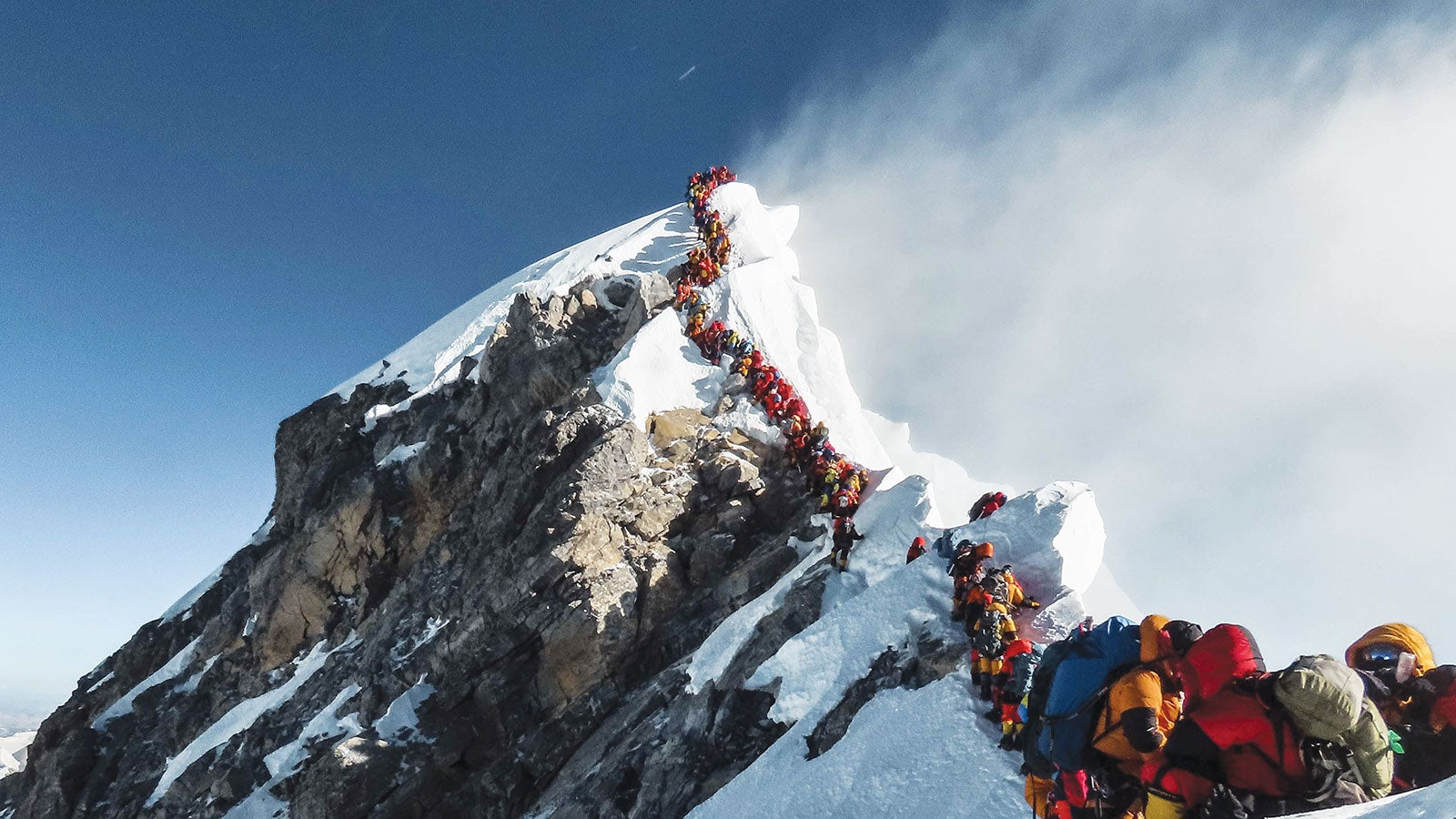

Too Many Tourists?
Summer 2019 | By Alan Fyall
Earlier this summer, a photo of people queuing to reach the top of Mount Everest launched a series of articles about the safety of climbers, the cause of the overcrowding, the impact on the mountain itself and how to solve the issue. At the heart of these inquiries are the questions: Why is there an increase in tourism, and what is the negative impact?
Tourism is hardly a new trend, but concern about the impact of an influx of visitors is a relatively modern one. Coined a few years ago, the term “overtourism” describes a reduction in the overall quality of life for locals and the tourist experience, of which the natural environment is so often a significant part. Like all complex phenomena, there is no quick-fix explanation as to the causes and remedies.
The biggest challenge remains managing the popularity of certain locations, from Yosemite in California to Everest in Nepal and Tibet, at a time when people are traveling more than ever.
The biggest challenge remains managing the popularity of certain locations, from Yosemite in California to Everest in Nepal and Tibet, at a time when people are traveling more than ever. International tourism receipts reached $1.7 trillion last year, an increase of 4 percent over 2017, representing nearly 30 percent of all service exports globally — exceeding the economic output of the global food and automotive industries.
A significant population growth across the globe and exponential growth in the middle classes in China and India, in particular, mean more people with more money to spend on items once viewed as a luxury. Cheaper airfares and the rise of more affordable services such as Uber and Airbnb have made travel to new places less expensive and easier. And there has been a growth in global demand, as a result of social media (Instagram perhaps being the biggest culprit with people even claiming, “I did it for the ’gram”) and new emerging markets.
There are certainly arguments to be made for the benefits of traveling: learning more about other cultures, boosting your confidence, creating memories, and learning more about yourself.
The tolls, however, can be vast. Though tourism to Everest brings in $300 million to Nepal every year, there is a human toll. More than 300 people have died on the mountain since 1953. This year’s climbing season saw 11 deaths, marking the deadliest season since 2015 when an avalanche killed 19 people at a base camp following a 7.8 earthquake. In part, the most recent death toll is due to Nepal increasing the number of permits issued this year to 381, leading to overcrowding, an influx of inexperienced climbers and a limited amount of oxygen tanks needed for climbing at higher levels. Inclement weather certainly played a role as well, as it does every year.
But there’s also the environmental toll. In June, an expedition crew removed 12 tons of garbage from the mountain, including “empty oxygen cylinders, plastic bottles, cans, batteries, food wrappings, fecal matter and kitchen waste,” according to a Nepal Army spokesperson.
Mount Everest is hardly the only locale facing the impact of overtourism. Thailand and Iceland have both closed popular destinations as a result of an increase in visitors. After being featured in the 2000 film The Beach , starring Leonardo DiCaprio, Maya Bay in Thailand experienced significant environmental damage — including decimated coral reefs, a declining mangrove population and receding beaches — due to the up to 6,000 people drawn daily to its once-pristine beauty. And in May, Iceland announced having to close Fjaðrárgljúfur, a canyon popularized in Justin Bieber’s 2015 music video, “I’ll Show You.” The natural formation faced erosion and damage to its sub-Arctic flora as a result of an additional 127,475 visitors from 2016 to 2018.
Fortunately, many solutions do exist. For example, responsible forms of tourism development, preemptive policies (especially with regard to air and cruise travel), the economic and environmental accounting and auditing of tourism development, and the dispersal of tourists to other areas can all play a part in mitigating the problem. So, too, can economic fees and taxes to limit demand and de-marketing strategies to reduce or re-direct demand. Solutions need to come from governments — and, frankly, from us.
Ultimately, we as tourists need to show some self-restraint and consider staying local sometimes. By reducing the amount of gas used during travel, staycations are perhaps the best way for us all to limit our carbon footprint — if not the most glamorous or social-media worthy.
Alan Fyall is the Visit Orlando Endowed Chair of Tourism Marketing in the Rosen College of Hospitality Management and is a member of UCF’s National Center for Integrated Coastal Research .
PHOTO BY @Nimsdai/Projectpossible.co.uk
Tourism is ruining everything special about Mount Everest
Stephen Venables, The Daily Telegraph
May 23rd, 2013 at 9:05 AM EDT
Whether mass tourism at Everest is a blessing or curse depends on who you ask: The economic boost for the Kathmandu government and mountain guides comes at the cost of the mountain’s cleanliness and prestige.
Samantha Shankman
Reaching the summit of Everest – or, rather, returning alive from it – has to be one of the most exhilarating experiences life can offer. But what really matters is how you reach the summit.
It used to be a prize earned through a long apprenticeship. Chris Bonington’s 1975 expedition brought the elite of British mountaineering to the previously unclimbed southwest face. When I climbed the mountain in 1988 it was my tenth Himalayan expedition. We too pioneered a new route, with just four climbers, no high-altitude porters, and no supplementary oxygen. The journey was everything; the outcome never a forgone conclusion.
Now, Everest has become the ultimate tick on the global adventure-tourism circuit. But, as the famous Tyrolean climber Reinhold Messner observed recently, the very term “adventure tourism” is often an oxymoron. Adventure is all about risk, uncertainty and self-determination – not buying a predictable, packaged commodity: you pay me £40,000 and I’ll make your dream come true.
Last year more than 500 people reached the summit, and this year more than 700 are expected. Yesterday climbers reported scenes of chaos as around 100 people tried to read the summit in the space of a few hours, while lengthy queues formed below trickier sections.
Mark Jenkins, covering the phenomenon for National Geographic , reported “garbage leaking out of the glaciers and pyramids of human excrement befouling the high camps”. But what appalled him most, as an experienced mountaineer, was the total abdication of personal responsibility, as he was forced to take his place on the human conveyor belt, clipped to a handrail behind scores of less competent people.
To be fair to the guides, the best of them run a slick operation and try strenously to clear litter from the mountain. Faced with the huge numbers of people, they probably have no option but to fix ropes virtually all the way from base camp to the summit. In terms of deaths per number of people on the mountain, Everest is statistically a much safer place than it used to be. It just seems sad to me that the western cwm – that extraordinary glacial basin that the Swiss in 1952 called “the Valley of Silence” – has become such a crowded place.
It would be easy to reduce the numbers. Until the late 1980s the Nepalese government allowed only one expedition at a time on any route on the south side. The Chinese operated a similar system in Tibet. Reinstate those rules and Everest would be peaceful again. Even better would be to ban the use of supplementary oxygen. H W Tilman, the great explorer, travel writer and leader of the 1938 Everest expedition, said that in his view “there is a cogent reason for not climbing it at all rather than climb it with the help of oxygen”. Why devalue the summit by effectively lowering its altitude from 8,850 metres to nearer 6,500 metres, to suit human capabilities? Remove what the Sherpas used to call “English air” and there wouldn’t be too many people on the summit.
Of course none of this is likely to happen. The American and European guides who struggle to make a decent living on their routine home mountains earn much better money from their annual Everest season. Their Sherpa colleagues make the kind of sums most Nepalese can only dream about. And, with climbing permits averaging about $10,000 a head, the Kathmandu government is raking in the cash. Everest is a lucrative seller’s market, and who wants to give that up?
So I suspect that this fat milch cow of a mountain, along with the other so-called “Seven Summits”, will remain an anachronism, while the real adventurers seek their challenges, and the solace of wild places, elsewhere.
Stephen Venables was the first Briton to climb Everest without supplementary oxygen. His book Higher than the Eagle Soars is an Arrow paperback. See stephenvenables.com
The Daily Newsletter
Our daily coverage of the global travel industry. Written by editors and analysts from across Skift’s brands.
Have a confidential tip for Skift? Get in touch
Tags: adventure , adventure travel , everest , tours
Photo credit: Tourists from Europe and the U.S. take a rest on the way to Mount Everest. Tianyake / Flickr
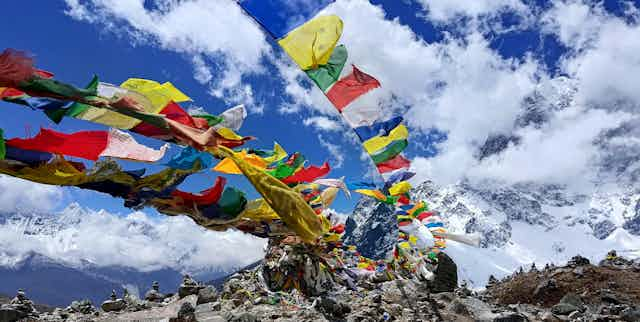
70 years after the first ascent of Everest, the impact of mass mountaineering must be confronted
Associate Professor in Tourism and Geography, Hainan University
Senior Lecturer in Tourism Management, Sheffield Hallam University
Adjunct Professor of Earth Science, University of Silesia in Katowice
Disclosure statement
The authors do not work for, consult, own shares in or receive funding from any company or organisation that would benefit from this article, and have disclosed no relevant affiliations beyond their academic appointment.
Sheffield Hallam University provides funding as a member of The Conversation UK.
View all partners
Mountains – their height, their mass, their climates and ecosystems – have fascinated humans for thousands of years. But there is one that holds extra-special meaning for many – Mount Everest, or Chomolungma as the Nepalese Sherpa people call it.
A sacred mountain for some, for others the world’s highest peak represents a challenge and a lifelong dream. Seventy years ago, on May 29, 1953, that challenge and dream became reality for two members of a British expedition : New Zealander Edmund Hillary and Sherpa Tenzing Norgay became the first people to reach the 8,848.86-metre summit.
Their achievement was a testament to endurance and determination. It was also the crowning glory of the British expedition’s nationalistic motivations on the eve of the young Queen Elizabeth’s coronation.
From our vantage in the present, it also represents a high point, not just in climbing terms, but in what we now think of as the modern era of mountaineering. Since then, mountaineering has become massively popular and commercial – with serious implications for the cultures and environments that sustain it.

Scaling the heights
The early mountaineering era began in 1786 when Jaques Balmat and Michel Paccard reached the summit of Mont Blanc, the highest peak in the European Alps at 4,808 metres. From 1854 to 1899 (known as the classic mountaineering period), advances in climbing technology saw ascending peaks by challenging routes become possible and popular.
During the modern era from 1900 to 1963, mountaineers pushed further into the Andes cordillera in South America, explored polar mountains and began high-altitude climbing in Central Asia.
Read more: How Mount Everest helped Britain's post-war bid to burnish global power credentials
Shishapangma, the last of the world’s 8,000-metre peaks to be climbed, was scaled in 1964 , marking the start of contemporary mountaineering. Since then, all of the world’s 8,000-metre peaks have been climbed in winter, culminating in the historic winter scaling of the 8,611-metre K2 by a Nepalese expedition in 2021.
The record-setting assault on the world’s 14 highest peaks by Nirmal Puja in 2019 set the stage for a new period of commercial mass mountaineering – involving expectations and conditions that would have stunned the likes of Hillary and Norgay.
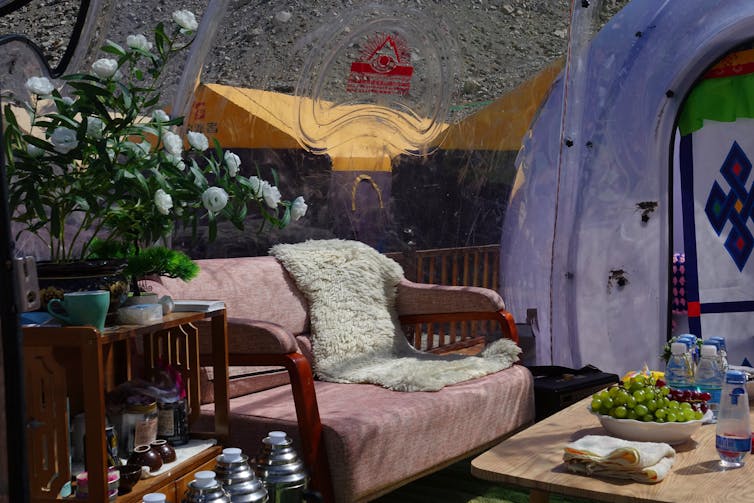
Mass mountaineering
The relatively recent influx of what some call novice mountaineers , who may expect luxury packages and a guarantee of summiting, can have dangerous consequences.
Sleeping in heated tents, not preparing their own food or helping to move equipment, does not test mental and physical fitness in such challenging environments. Pushing to the summit may put their own lives, and the lives of other climbers and rescue teams, at risk.
And yet the number of people attempting to climb famous peaks such as Kilimanjaro in Tanzania or Aconcagua in Argentina has increased dramatically. In 2019, there were 878 successful summits on Everest alone.
Read more: Death on Everest: the boom in climbing tourism is dangerous and unsustainable
The days when true mountaineers were looking for new routes and climbing with minimum support have almost disappeared from commercial peaks like Everest. And many of these commercial climbers would not have a chance without professional support.
In 1992, for example, when the first commercial mountaineering expeditions on Everest began, 22 Sherpas and 65 paying mountaineers summited – one Sherpa for three clients. Nowadays , two or even three Sherpas for each member of a commercial expedition is common.
But the romance and achievements of past mountaineers, combined with social media images and an “all-inclusive” adventure tourism industry, can lull inexperienced climbers into a false sense of security. On Everest, this has led to overcrowding, environmental degradation and increased risks for all climbers .
During the first two years of the COVID-19 pandemic, Nepal’s Khumbu region – where Everest sits – was effectively shut for climbing. This year, however, some estimate a record of more than 1,000 people could reach the summit.
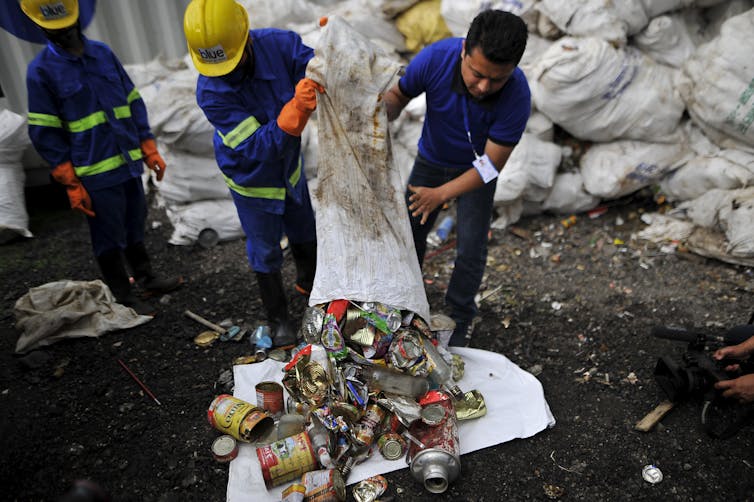
The next challenge
Experienced mountaineers are responding to the challenges of overcrowding, pollution and socio-cultural impacts on mountain communities by advocating for more responsible and sustainable mountaineering practices.
They want stricter regulations and better training to protect the fragile ecosystems of the Himalayas and other mountain ranges worldwide.
Read more: Is it time to stop climbing mountains? Obsession with reaching summits is a modern invention
This will require many stakeholders to play their part, including governments, mountaineering organisations, tourism operators and local communities. Ultimately, the future of mountaineering depends on preserving these unique mountain environments in the first place.
Finally, maybe it’s time to introduce minimum skill requirements for climbing the world’s highest peak.
As we mark the 70th anniversary of the first ascent of Everest, we need to reflect on the changes that have taken place in mountaineering since. Paradoxically, while it has become more accessible and popular, it has also become more challenging and complex.
Meeting those challenges and solving the problems will be the best way to honour the extraordinary achievement of Edmund Hillary and Tenzing Norgay.
- Mountaineering
- Mount Everest
- New Zealand stories
- Edmund Hillary

Scheduling Analyst

Assistant Editor - 1 year cadetship

Executive Dean, Faculty of Health

Lecturer/Senior Lecturer, Earth System Science (School of Science)

Sydney Horizon Educators (Identified)
Press Release
Climate change and human impacts are altering mt. everest faster and more significantly than previously known.

Photograph by National Geographic Rolex Logo Lockup
November 20, 2020 Washington, D.C . -- Today, new findings from the most comprehensive scientific expedition to Mt. Everest in history have been released in the interdisciplinary scientific journal One Earth . Featuring a collection of research papers and commentaries on Mt. Everest, known locally as Sagarmatha and Chomolangma, the research identifies critical information about the Earth’s highest-mountain glaciers and the impacts they are experiencing due to climate change. As part of the 2019 National Geographic and Rolex Perpetual Planet Everest Expedition, climate scientists studied the environmental changes including Everest’s “death zone” to understand future impacts for life on Earth as global temperatures rise.
This new research fills a critical knowledge gap on the health and status of high-mountain environments, which are incredibly difficult to study due to the inhospitable environmental conditions. Key findings include:
- The highest-ever recorded sample of microplastics was found on the “Balcony” of Mt. Everest at 8,440 m, one of the last resting spots before reaching the summit. This microplastic is likely coming from the clothing and equipment worn by climbers, highlighting the impacts of humans on even the highest reaches of our planet.
- Researchers surveyed nearly 80 glaciers around Mt. Everest and found evidence of consistent glacial mass loss over the last 60 years and that glaciers are thinning, even at extreme altitudes above 6,000 m. Using declassified spy satellites and a new highest-resolution data set, this is the most complete assessment of the status of the world’s highest glacier as a baseline for future research on its changes.
- Additionally, the research captures the first documented surge of a glacier (when it moves 10 to 100 times faster than it normally does) in the Mt. Everest region, a phenomenon that can put people and communities at risk.
Glaciers like those on Everest provide ⅕ of the global population with a steady supply of fresh water around the world. But due to the extreme conditions of these high mountains, little information up until now has existed about the impacts of climate change at elevations above 5,000m.
“Mountains and their rapidly-disappearing glaciers are the “water towers” of our planet, storing and transporting freshwater to nearly two billion people around the world. That water supply is increasingly under threat due to rising temperatures, melting glaciers, pollution, and other human-caused and environmental stressors,” said Paul Mayewski, Scientific and Expedition Lead, and Director, Climate Change Institute University of Maine, and lead author of the preview “Pushing Climate Change Science to the Roof of the World” published in One Earth.
Microplastic pollution at the highest point on Earth is a direct result of increased tourism and waste accumulation. A large proportion of that waste is made out of non-biodegradable plastic. While visible plastic has been reported on Mt. Everest previously, the pristine environment at Earth’s highest peaks is changing. The new data highlights that the collected snow samples had significantly more microplastics compared to the stream samples, with the majority of microplastics being fibrous.
“With increased tourism, microplastics throughout Mt. Everest is expected to rise, creating issues for the environment and people of the Khumbu region,” said Imogen Napper, National Geographic Explorer and first author of “Reaching New Heights in Plastic Pollution — Preliminary Findings of Microplastics on Mount Everest."
Results from the highest weather stations in the world demonstrate that the majority of precipitation to the Mt. Everest region is sourced in the Bay of Bengal, highlighting the importance of atmospheric circulation to high mountain glaciers. Further, the weather stations enabled a full reconstruction of climber’s oxygen availability during past Everest summit attempts to generate a comparison of climbing difficulty.
From April to May 2019, an international, multidisciplinary team of scientists conducted the most comprehensive single scientific expedition to Mt. Everest in the Khumbu Region of Nepal as part of the National Geographic and Rolex partnership. Team members from eight countries, including 17 Nepali researchers conducted trailblazing research in five areas of science that are critical to understanding environmental changes and their impacts: biology, glaciology, meteorology, geology and mapping.
Scientists are now utilizing the samples and data they collected during the Expedition to gain unique insights into how climate change and human populations are affecting even the highest reaches of our planet. Even the highest glaciers on Earth are reeling from human activity around the globe.
“Mountains will outlast us,” the One Earth editorial team wrote in its “The Changing Face of Mountains” editorial. “But without immediate action and integrated approaches to adaptation and sustainable development, they will lose their majesty. They will become diminished. With consequences for us all.”
Papers from the National Geographic collaboration include:
- King et al.: “Six decades of glacier mass changes around Mt. Everest revealed by historical and contemporary images,” an Article publishing in One Earth (ONEEAR266)
- Napper et al.: “Reaching new heights in plastic pollution – preliminary findings of microplastics on Mount Everest,” an Article publishing in One Earth (ONEEAR267)
- Perry et al.: “Precipitation Characteristics and Moisture Source Regions on Mt. Everest in the Khumbu, Nepal,” an Article publishing in One Earth (ONEEAR258)
- Matthews et al.: “Into Thick(er) Air? Oxygen Availability at Humans’ Physiological Frontier on Mount Everest,” an Article publishing in iScience (ISCI101718)
- Elvin et al.: “Behind the scenes of a comprehensive scientific expedition to Mt. Everest,” a Backstory publishing in One Earth (ONEEAR253)
- Mayewski et al.: “Climate Change in the Hindu Kush Himalayas: Basis and Gaps,” a Reflection publishing in One Earth (ONEEAR254)
- Miner et al.: “An overview of physical risks in the Mt. Everest region,” a Primer publishing in One Earth (ONEEAR255)
- “Voices from the roof of the world,” a collection of 6 Voices publishing in One Earth (ONEEAR252)
- Mayewski et al.: “Pushing Climate Change Science to the Roof of the World,” a Preview publishing in One Earth (ONEEAR268)
- Elmore et al.: “Understanding the World’s Water Towers through High-Mountain Expeditions and Scientific Discovery,” a Preview publishing in One Earth (ONEEAR264)
- “Everest Night Lights,” a Visual Earth publishing in One Earth (ONEEAR265)
- “Birth of Sagarmatha,” a Visual Earth publishing in One Earth (ONEEAR269)
This work was supported by the National Geographic Society and Rolex. To learn more about the Everest Expedition, please visit: https://www.nationalgeographic.org/projects/perpetual-planet/everest/ and tune into our YouTube page to get a closer look at the 2019 National Geographic and Rolex Perpetual Planet Everest Expedition
Related Files:
PDFs of all papers
Selection of images available for media use
To embed videos related to the National Geographic and Rolex Perpetual Planet Everest Expedition, please visit:
- Everest Expedition
- Meteorology
- 360: The Science
- 360: The Mission
Media Contact
The National Geographic Society is a global nonprofit organization that uses the power of science, exploration, education and storytelling to illuminate and protect the wonder of our world. Since 1888, National Geographic has pushed the boundaries of exploration, investing in bold people and transformative ideas, providing more than 15,000 grants for work across all seven continents, reaching 3 million students each year through education offerings, and engaging audiences around the globe through signature experiences, stories and content. To learn more, visit www.nationalgeographic.org or follow us on Instagram , LinkedIn, and Facebook .
- International edition
- Australia edition
- Europe edition
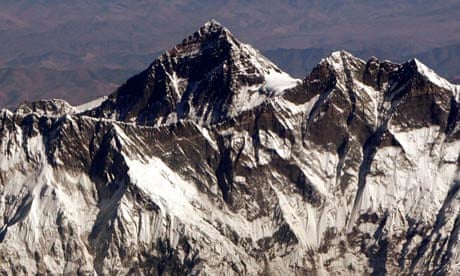
The mission to clean up Mount Everest
T he people who set out to climb Everest spend months dreaming about reaching the summit. They pay $65,000 (£41,000) in fees to the Nepali government; they train, trek for days, endure extreme discomfort, even danger. So it should be a simple thing to get them to pick up after themselves.
Apparently not. Nearly 60 years after Edmund Hillary conquered Everest, and 30 years after climbing turned commercial, the region is still struggling to deal with mass tourism.
By the standards of the 70s, when the main climbing routes were littered with discarded tents and food packets, Everest is a lot cleaner, with just a smattering of plastic bottles and sweet wrappers on the rocky plateau that is base camp. But a Nepali environmental coalition is pressing the government in Kathmandu to adopt a new management plan to safeguard the Himalayas in the age of mass tourism – and to make amends for the environmental sins of the past.
"Everybody talks about waste in the mountains but nobody talks about proper solutions," says Phinjo Sherpa, director of Eco Himal. "Cleaning up Everest every once in a while does not help. The main thing is management, waste management." The group has lodged a plan with the government that calls for tougher penalties against litterbugs at Everest and the surrounding areas. They are also pushing for the installation of portable toilets at base camp and investment in waste treatment facilities – which currently do not exist in the region – with proposals for five incinerators and sewage treatment plants.
It's difficult to tread lightly in the high-altitude environment, especially in areas this remote. The first expeditions to Everest were monumental in scale. The 1953 attempt, which brought success to Hillary, set off from Kathmandu with 1,200 porters for their equipment, according to Kancha Sherpa, the last surviving member of the team that made it to base camp.
The 1953 expedition required 25 wooden crates just to carry the coins they would spend along the way. A single oxygen bottle weighed 15kg. As for dealing with the detritus of such a huge human endeavour, Kancha looks blank. "You have to remember that was a long time ago. Things were very different then," he says. Even Hillary admitted to leaving equipment behind, and more than 2,500 people have made it to the summit since his day. The heavy traffic left its mark. "People were careless. They would take a rubbish bag but they would still leave stuff behind," said Tshering Tenzing Sherpa, an official of the Sagarmatha Pollution Control Committee, the NGO charged with overseeing the Everest cleanup.
Modern expeditions are much more conscious of their footprint. Groups must pay a $4,000 (£2,500) deposit on their equipment – in the hope that they will carry down everything they brought. Repeat visitors to Everest see a difference. "It's visibly and spectacularly better," says Jan Morava, an electrical engineer from the Toronto area who was attempting the summit with his brother and a climber from the UAE. "There were piles of rubbish in base camp before."
But conservation groups say the deposit is small compared with the other expenses associated with an ascent on Everest. They also argue the Sagarmatha Pollution Control Committee lacks the resources to keep up with all the groups climbing Everest and to make sure that do indeed carry all their equipment back down to Kathmandu.
The committee says it brought back 25 tonnes of rubbish from Everest last spring – including 12,000kg of paper and plastic and 11,250kg of human waste. But conservationists argue that waste disposal is haphazard. There are rubbish dumps with heaps of tuna cans and plastic bottles only a few minutes' walk away from villages on the trekking trail.
On a trek near the village of Lobuche last May, Alton Byers of the Mountain Institute came across a 10 sq metre open pit of human waste, hauled down from Everest, close to a seasonal stream. The pit had been covered over by the time of a subsequent visit in May.
And, says Tshering, there is plenty more detritus of the past still out there – rubbish discarded by climbers years and even decades ago, preserved in ice and snow. "Just above the ice falls at crampon point you can see cans from 10, 20, 30 years ago or even older," Tshering says. "There's a lot of old rubbish out there."
Other high peaks less famous than Everest are even dirtier, notes Tshering. And with climate change, snow and ice on mountaintops is melting, exposing even more rubbish. "We are in a garbage race," he says.
- Changing Himalayas
- Climbing holidays
- Mount Everest
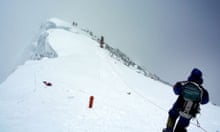
Everest 'traffic jam' could happen again, Nepal officials say

Mount Everest claims fourth victim of weekend

Three climbers die on Everest descent
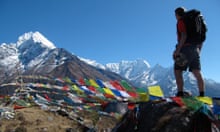
Everest, the grandaddy of walking adventures
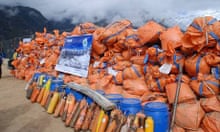
Calls for long-term Everest waste management plan – starting with toilets

Everest pioneer's Olympic medal heads to summit
Comments (…), most viewed.
- Sustainability
- Latest News
- News Reports
- Documentaries & Shows
- TV Schedule
- CNA938 Live
- Radio Schedule
- Singapore Parliament
- Mental Health
- Interactives
- Entertainment
- Style & Beauty
- Experiences
- Remarkable Living
- Send us a news tip
- Events & Partnerships
- Business Blueprint
- Health Matters
- The Asian Traveller
Trending Topics
Follow our news, recent searches, commentary: climbers have turned mount everest into a high-altitude garbage dump, advertisement.
Climber and trekker numbers have skyrocketed in the past 20 years, exacerbating Mount Everest’s trash problem, say these academics.
This picture taken on May 23, 2010 shows a Nepalese sherpa collecting garbage, left by climbers, at an altitude of 8,000m at Mount Everest. (Photo: AFP/Namgyal SHERPA)
Suzanne OConnell
Alton c byers.
MIDDLETOWN, Connecticut: Spring is go time for climbers who hope to summit Mount Everest, Earth’s highest peak above sea level. Hundreds of mountaineers from around the world travel to Asia in April and May, headed for base camps in Nepal and Tibet.
But jagged peaks won’t be the only thing they see. Especially on Everest’s more heavily traversed Nepal side, they’ll find fields of garbage - including cans, bottles, plastic, and human and animal excrement.
Each year, more than 60,000 trekkers and climbers visit the Sagarmatha National Park and Buffer Zone, a high-altitude swath of the Khumbu region in northeast Nepal that includes Everest and seven other peaks. Some 400 to 500 climbers attempt to summit Everest every year.
The trash problem first became evident in the 1980s and 1990s, when climbing on the mountain and trekking in Khumbu began to increase. Climber and trekker numbers have further skyrocketed in the past 20 years.
Most coverage of this issue focuses on negative and sensational aspects, such as the frozen bodies of climbers who remain where they died on the mountain because removal operations are risky and expensive.
We are scholars who study geoscience and mountain geography, and one of us (Alton Byers) has lived in Nepal and worked with communities around Everest. We are encouraged to see increased efforts to address Everest’s massive trash problem. In our view, modern technology and international cooperation are key to ending the pileup of waste in this iconic setting.
POLLUTION FROM WASTE
For most visitors to this area of the Himalayas, Everest base camp on the upper reaches of the rapidly receding Khumbu Glacier is the ultimate destination, at an altitude of 5,364m. Formerly a two- to three-week trek from Kathmandu, today the journey is most likely to begin at the Lukla Airport, which sits about 60km from base camp.
Climbers who aim to summit Everest typically spend up to two months on the mountain, including weeks making short, incremental ascents above base camp and back down again. This enables them to acclimate to the altitude before climbing to higher camps and then to the summit.
Much of the food and equipment headed to Everest also begins its journey at Lukla. Some is shipped to base camp by helicopter, but much of the gear is carried there by yaks, yak/cattle crossbreeds called dzopkio, mules and horses.
Lots of equipment, food and packaging, plus animals and porters, means a lot of garbage. A 2010 study estimated that park tourism generated 4.6 tonnes of solid waste per day during peak tourist periods in April to May and October to November.
Eventually most of this refuse is dumped into unsightly landfills a short distance from local villages. There it is burned, adding particulates and toxic chemicals to the air. The remaining ash is buried, where it can contaminate groundwater.
At the base camp, microplastics - likely from discarded mountaineering clothing, tents, ropes and boots - have been found in water and snow samples. High levels of perfluoroalkyl and polyfluoroalkyl substances, or PFAS, widely known as “ forever chemicals ,” have been found on the Khumbu glacier, probably from materials used to waterproof climbing boots, tents and clothing.
These substances could pose health risks for transient climbers, but are a more serious threat for people who live in the nearby settlements of Gorak Shep, Lobuche, Dugla and Pheriche for most of the year. Some of these villagers work at Everest base camp and are exposed there too.
And then there’s sewage. Most septic tanks at the hundreds of lodges located throughout the national park and buffer zone leak, further polluting groundwater. Camp Four, the last site that climbers occupy before they attempt to summit Everest, is covered with garbage and frozen, wind-swept faeces.
National parks in developed countries have infrastructure to handle waste management, trash pickup, recycling and wastewater treatment. At Everest base camp, there are just collection barrels under toilets. Each year, some 22,000kg of human waste are brought to landfills several kilometres away.

Commentary: 70 years after the first ascent of Everest, the impact of mass mountaineering must be confronted

Commentary: What if failure is an option? The gamble of mountain climbing for this Singaporean
Solutions for sustainable tourism.
Recognising the scale of this problem, initiatives are in progress to develop solutions.
The Sagarmatha Pollution Control Committee, created by local Sherpa people in 1991, is an Indigenous nonprofit organisation that is responsible for monitoring garbage in the permit-required mountains and peaks. The group focuses on litter control and periodic base camp cleanups.
In 2014, the government of Nepal began requiring every mountaineer who climbs above the Everest base camp to bring back 8kg of solid waste from the mountain or forfeit a US$4,000 deposit. Of course, if you’ve paid US$75,000 or more for the trip, losing the deposit may not be much of an incentive. Many people elect to forfeit it.
A nonprofit called Sagarmatha Next, established in 2019, is working to promote sustainable tourism in the Khumbu region, partnering with companies and organisations from around the world. The group has raised awareness by producing art works and souvenirs from trash.
It also launched a “Carry Me Back” programme that encourages tourists to take one-kilogram bags of solid waste, such as shredded plastic bottles, to the airstrip at Lukla for processing and disposal in Kathmandu.
At the local government’s request, the University of Colorado Boulder developed a sustainable solid waste management plan in 2019 for the national park and buffer zone.
The COVID-19 pandemic delayed implementation of the plan, which proposes creating a five-step process: Waste segregation, collection, sorting and shredding, transfer to shipment stations and transportation to recycling facilities in Kathmandu.

Commentary: Travelling has become a race to look good online

Commentary: Travellers are hoping for a fare shake-up as airlines reap record profits
Another nonprofit initiative, the NeverRest Project, was created during the pandemic to provide environmental solutions for Mount Everest and other fragile ecosystems around the world. NeverRest is working with the Nepal Tourism Board to revolutionise high-altitude waste management using modern technology.
In 2023, the organisation presented a concept plan for a sustainable Everest base camp that would install technologies such as portable solar tents to reduce use of fossil fuel; unisex portable urinals with multi-use filters that convert urine into water; incinerator toilets that transform human waste into ash; and modular geodesic dome tents designed for effective heat retention to reduce energy use.
In the 71 years since Sir Edmund Hillary and Sherpa Tenzing Norgay made the first known successful ascent of Mount Everest, this peak has been a setting for daring expeditions, triumphs and tragedies.
We hope that the region’s garbage problem soon will fade into history as new approaches and technologies provide solutions for Everest and other remote high-mountain locations around the world.
Suzanne OConnell is Harold T Stearns Professor of Earth Science at Wesleyan University. Alton C Byers is Senior Research Associate at the Institute of Arctic and Alpine Research, University of Colorado Boulder. This commentary first appeared on The Conversation.
Related Topics
Also worth reading, this browser is no longer supported.
We know it's a hassle to switch browsers but we want your experience with CNA to be fast, secure and the best it can possibly be.
To continue, upgrade to a supported browser or, for the finest experience, download the mobile app.
Upgraded but still having issues? Contact us

The mass tourism industry EXPLAINED
Disclaimer: Some posts on Tourism Teacher may contain affiliate links. If you appreciate this content, you can show your support by making a purchase through these links or by buying me a coffee . Thank you for your support!
Mass tourism is a prominent part of the tourism industry. Associated with the traditional package holiday, well-known holiday resorts and famous tourist attractions, many areas both benefit and suffer at the hands of mass tourism. But what exactly is mass tourism and how does it impact the wider tourism industry?
In this article I will explain what mass tourism is, with some useful definitions. I will then outline the characteristics of mass tourism, the evolution of mass tourism and the positive and negative impacts of mass tourism. Lastly, I will provide some examples off destinations that are known for their mass tourism industries.
What is mass tourism?
Mass tourism definitions, extreme concentration of tourists, saturation of a destination, organised groups, accessibility, media and promotion, the stage of consolidation, psychocentric tourists, how did mass tourism evolve, enclave tourism, beach holidays, theme parks, major tourist attractions, mountain climbing, positive impacts of mass tourism, negative impacts of mass tourism, how can we manage mass tourism in a sustainable way, mass tourism destinations, mass tourism: conclusion, further reading.
Well, the clue is in the title!
Mass tourism is essentially tourism that involves ‘the masses’.
So, what is a mass? Well, this is not exactly clear. But lets just say its usually a lot- like thousands or tens of thousands or more.
Mass tourism can occur in a variety of tourism situations. It could be a coastal resort, such as Benidorm. It could be an area that is home to a major tourist attractions, such as the Great Wall of China . It could be a picturesque village or remote island.
Wherever mass tourism occurs, it relies on the same concept- there are large amounts of tourists , often filling or exceeding capacity, in a given location at one time.
For decades, mass tourism has been a widely used term in tourism literature as well as in wider society. Yet, to this day there has never been a clearly agreed definition and content.
According to Poon (1993), mass tourism refers to the movement of a large number of organised tourists to popular holiday destinations for recreational purposes. It is a phenomenon which is characterised by the use of standardised package products and mass consumption. Conceptually, this type of tourism features standardized leisure products and experiences packaged for mass tourists.
Hilallali (2003) describes mass tourism as ‘an offspring of industrialisation and democracy, good student of consumption and globalisation .
As noted by Dehoorne et Theng in 2015, Mass tourism is the epitome of aggressively large-scale sold standardized packages stands in stark opposition to elite or luxury tourism.
Naumov and Green (2016) state that mass tourism refers to the movement of a large number of organised tourists to popular holiday destinations for recreational purposes.
Whilst these definitions are useful, I personally feel that they are all missing some important detail. These definitions quite rightly acknowledge the fact that organised packaged tourism products are significant facilitators of mass tourism. But they fail to acknowledge the growing dynamic independent tourist.
In today’s world, consumers are more independent than ever. We can find a cheaper deal online ourselves than what the travel agent is offering. We can plan our own itinerary using the information presented by travel blogs. We don’t need a guide when we can download the information we need on our phones. But just because we are not part of a mass organised group, does not mean that we are not mass tourists.
Thousands of tourists flock to Santorini’s picturesque white streets each July. Thousands of people line the streets of Shanghai to get a look at the light show on the Bund each evening. People struggle to get a photo without the crowds of tourists behind them at the Pyramids of Giza in Egypt. Are all of these people on an organised package holiday? I very much doubt it.
In reality, most attempts to define the concept of mass tourism are indeed outdated, failing to take into account post-modern tourist motivations and behaviours. In light of this, I have developed my own definition of mass tourism below…
Mass tourism can be defined as ‘extreme concentrations of tourists in any one place, resulting in saturation of the place’. Mass tourism cannot be characterised by specific numbers or values, because every destination has different carrying capacities. Rather, mass tourism occurs when there are too many tourists for a destination to comfortably accommodate.

Characteristics of mass tourism
OK, so now we have defined mass tourism, what are the identifying characteristics? The most notable characteristics of mass tourism include: extreme concentrations of tourists; the saturation of a destination, travel in organised groups, good accessibility to a destination, media influence, the stage of consolidation and tourists who are described as psychocentric.
I will explain what each of these means below.
The most obviously characteristic of mass tourism is that there are a lot of tourists. What is a lot, I hear you say? Well, I can’t quite answer that question-sorry.
Each type of tourist destination is different. Some places are big, others are small. In fact, what is a destination? Well, this isn’t entirely clear either.
In the context of mass tourism, a destination could be a city, a holiday resort or the area surrounding a popular tourist attraction. The size of the destination doesn’t actually matter though. The important fact is that there are more tourists that come to the area at a given time than the destination can comfortably cope with.
OK, so here comes another subjective term- what does ‘comfortably cope’ mean? Well, what I mean by this, is that if the tourism has adverse effects as a result of the visitor numbers, it is no longer ‘comfortably coping’. This could include environmental degradation, gentrification or adverse social impacts, for example.
So the major characteristic associated with mass tourism is that there are too many tourists in a given area, big or small.
Having too many tourists leads to saturation of a tourist destination.
If a tourist destination is saturated, there are likely to be more tourists than members of the local community. Revenue from tourism-related activities is likely to dominate the economy. Many of the negative economic , environmental and social impacts of tourism are notable.
Mass tourism is generally associated with the concept of overtourism . Overtourism refers to the issue of having too many visitors in a given time in a given place, which impacts negatively on the tourist experience, the host community and environment.
Overtourism is a growing problem that can only be resolved by adopting principles of sustainable tourism management.
Mass tourism is associated with organised and packaged tourism.
Whilst not all mass tourists are package tourists, there is definitely a linear relationship between the two.
By default, group organised holidays bring large amounts of tourists to a destination at the same time. Whether this by via a coach tour, a day trip or through a tour operator, travel in organised groups brings large amounts of tourists together in one place at one time.
Group tourism is usually organised in a place because it has some particular value to the tourist. For example, there are many tours to visit the famous Abu Simbel attraction in Aswan, Egypt. Likewise, Sharm el Sheikh is a popular destination for package holidays and enclave tourism .
Mass tourism is directly associated with good accessibility.
The advent of the low cost airline largely fuelled the growth of the mass tourism industry. Airlines such as easyJet and Wizz Air put new tourist destinations on the map and helped to transport more tourists to existing tourist destinations than areas could [can] comfortable cope with.
Cheap flights has meant that many areas have become saturated with tourism. Cheap flights means that more people can afford to go on holiday, more often.
But accessibility isn’t just about price. The past two decades have seen the number of available flights increase exponentially. This has meant that destinations are more accessible to tourists.
Likewise, many destinations have become more accessible because they have developed their transport infrastructure. New airports, new roadways and improved rail infrastructure has meant that more tourists can reach more destinations around the world than ever before.
If we don’t know about a place then we don’t go to a place.
The media has placed a significant role in the growth of tourism to particular areas. From episodes of Karl Pilkington’s Idiot Abroad to Travel Man, starring Richard Ayoade , to Leonardo Dicaprio’s famous film, The Beach , there are plenty of places that have made their way to fame through the media.
One of the most notable developments in the promotion of tourist destinations is the development of social media. Have you ever heard of Insta tourism ? Yep- it’s a an actual type of tourism !
Social media platforms have raised awareness of many tourist destinations around the world that had previously featured only deep in our guidebooks.
In particular, Instagram’s geotagging function enables social media influencers to display the exact location of where their photographs were taken. This has resulted in tourists flocking to areas around the world that had previously experienced little or no tourism.

Butler, in his Tourism Area Life Cycle model , outlines the way in which a destination grows and evolves. In his model, there is a clear point at which tourist numbers are at their highest. This is the time when tourism is fully developed and is starting to the negative experience impacts associated with overtourism .
When tourism reaches the stage of consolidation in a destination, it is likely that it is also experiencing the concept of mass tourism.

Similarly to Butler, Plog looked at tourist motivations, mapping them to particular times during a destination’s development in his model of allocentricity and psychocentricity .
Plog demonstrated in his typological assessment, that when a tourist is classified as a psychometric tourist, they are likely to pertain to mass tourism as their primary choice of holiday type.
Psychocentric tourists typically travel in organised groups. Their holidays are typically organised for them by their travel agent . These travellers seek the familiar. They are happy in the knowledge that their holiday resort will provide them with their home comforts. These tourists enjoy holiday resorts and all inclusive packages . They are components of enclave tourism , meaning that they are likely to stay put in their hotel for the majority of the duration of their holiday. These are often repeat tourists, who choose to visit the same destination year-on-year.
The history of tourism is a long one and mass tourism plays a key role in the growth and development of the tourism industry .
The origins of mass tourism can be traced back to 1851, when Thomas Cook led his first organised group of tourists to the Great Exhibition in London. While his business model did change and adapt over the years, the concept remained the same- organised group travel.
Over time, more and more people were able to travel. After World War ii, people began to have more disposable income and new legislation was brought in to ensure that workers had paid holidays each year.
At the same time, destinations became more developed. They developed their transport infrastructure, promoted their destination for tourism and built the facilities and amenities that tourists required.
Mass tourism notably developed in Western societies since the 1950s. This was the result of a period of strong economic growth. Mass tourism was first seen in Western Europe, North America and Japan as these countries had strong economies and thus the general public were wealthier overall.
Globalisation has also fuelled the mass tourism industry. People can find the familiar on their travels. There are less surprises than there once was. We can research our trip on the Internet and watch travel shows to familiarise ourselves before we travel.
The mass tourism industry really started to boom with the advent of the low cost carrier . The average UK outbound tourist went from having one two week holiday per year to taking a big holiday and a couple of short breaks. People who couldn’t afford to go on holiday before, were now being brought into the market.
Types of mass tourism
Although many people associate mass tourism predominantly with the traditional package holiday model, there are in fact many different types of mass tourism.

Examples of enclave tourism destinations : Sharm el Sheikh, Egypt ; Kusadasi, Turkey; Costa Blanca, Spain.
Mass tourism is commonly associated with enclave tourism .
Enclave tourism is essentially tourism that takes place in a space that is segregated from the community outside. It is in its own ‘bubble’, so to speak.
Enclave tourism implies a conscious decision to segregate tourists from the general population . This is usually in the context of an all-inclusive environment such as a cruise ship, hotel or resort complex.
Enclaves are enclosed and self-contained physically, socially, and economically. This means that tourists have hardly any reasons to leave the enclave.

Examples of mass tourism beach destinations: Benidorm, Spain; Phuket, Thailand; Kuta, Bali .
There are many beach areas where the destinations have become overdeveloped. These are most commonly located in Western Europe, although they are found all around the world. It is these overdeveloped beach areas that are most commonly associated with mass tourism.
Mass tourism beach holidays have traditionally been the bread and butter for travel agents . Up until this day, high street travel agents are filled with holidays brochures boasting photo after photo of beautiful beaches and swimming pools.
With the lack of British sunshine and seemingly endless rainy days, it is no surprise that Brits, amongst other nationalities, seek warmer climes. Thomas Cook’s products were among the first to provide British holiday makers with the typical sun, sea and sand experience, but there have since been many more players enter the market.

Examples of mass ski destinations: Andorra, Italy ; Chamonix, France; Breckonridge, USA.
There are many ski resorts that have developed to such a stage that they can now be classified as mass tourism destinations.
Popular throughout the winter months, many tourists flock to ski destinations for their holiday. This is especially popular in the Alps in Europe and the Rockies in the USA and Canada.
Ski holidays are also often sold as a packaged product by travel agents, composing of flights, transfers, accommodation and ski rental/lessons.

Examples of mass tourism in theme parks: Universal Studios Florida , USA; Alton Towers, UK; Disney Shanghai, China.
Theme parks attract large amounts of tourists.
Disney Land, Paris attracts around 15 million tourists each year, Disney Land in Tokyo has approximately 18 million visitors and Magic Kingdom at Walt Disney Florida has more than 20 million tourists each year! Wow, that’s a lot!
People who visit theme parks also often provide a tourism boost for local areas too. People may choose to eat at nearby restaurants or stay in nearby hotels.

Mass tourism events: Hogmonay, Edinburgh, UK; Rio Carnival, Brazil; San Fermin , Spain.
Mass tourism occurs when large numbers of people undertake tourism-related activities in the same place at the same time. This is often the case with major events.
From the Olympics to the Day of the Dead Festival in Mexico, events attract tourists all over the world.
Mass tourism caused from events can out a strain on locals areas, which may not be equipped to deal with the influx of visitors.

Examples of major tourist attractions attracting the masses: The Eiffel Tower, France ; The Pyramids of Giza, Egypt; The Great Wall, China.
Many tourists will travel to an area to visit a particular tourist attraction. Whether this is a museum in Paris, a war memorial in Washington or an underground cave in Jeju , South Korea, tourist attractions are often the main appeal of a tourist destination .
Major tourist attractions can attract masses of tourists, who then spend time in the surrounding area, thus making the area a mass tourism destination.

Examples of mass tourism cruise areas: The Caribbean; the Mediterranean.
Cruise tourism is one of the most popular types of tourism .
Cruises come in all shapes and sizes and the smaller ones are obviously not examples of mass tourism. However, some cruise ships are so big that they are the size of a small city!
The largest cruise ships in the world have a capacity of more than 5000 tourists. These tourists will disembark en mass when the ship docks at various locations, causing an influx of tourists to said destinations over a short period of time.

Examples of mountain climbing where tourist numbers exceed capacity: Mount Everest; Mount Kilimanjaro.
Mass tourism when climbing a mountain? Surely not? Well actually- yes.
OK so you are not getting thousands of tourists like you might on a cruise ship or in a beach resort, but like I explained earlier, mass tourism is not about specific numbers- it is when the numbers exceed capacity.
Sadly, there have been many stories in recent years of capacity issues when climbing mountains. The most notable is on Mount Everest, where tourists have dies as a result of queuing at high altitude.
Whilst mass tourism is most commonly discussed because of its negative impacts, there are actually some positive impacts of mass tourism too.
Mass tourism makes money. That’s the number one motivator for all destinations who allow areas to evolve into mass tourism destinations (not sure what I mean? Take a look at Butler’s Tourism Area Life Cycle model ). After all, money is what makes the world go round, right?
Mass tourism brings lots of tourists. Lots of tourists spend lots of money. This supports economic growth in the local area and enables the destination to spend or reinvest the money that is made in a way that is appropriate for that particular area. Some destinations may build more hotels. Other may make financial investments. Some may spend more money on public health services or education.
However they choose to spend their money, it is money which is the motivation for tourism development.
Mass tourism creates many jobs. This also helps to boost the local economy as well as supporting livelihoods. Jobs can be directly related to tourism (i.e. a hotel waiter or a holiday representative) or they can be indirectly related to tourism (i.e. the fisherman who supplies fish to the hotels).
You can read more about the positive economic impacts of tourism here .
Mass tourism has gained a pretty bad reputation in recent years. If you Google the term ‘mass tourism’ you will be largely greeted with articles that discuss the negative impacts on the environment and society.
Mass tourism creates intense environmental pressures due to the fact that such activity involves a large number of tourists in small areas. The environmental impacts of tourism include aspects such as littering, erosion, displacement of animals, damage to flora and fauna and reduction in air quality, to name but a few.
Mass tourism can also cause significant social impacts . Gentrification, increases in crime, loss of culture and authenticity and cultural ignorance are just some of the ways that large amount of tourists in a given area can negatively effect the local society.
The other major problem is economic leakage . Whilst mass tourism creates significant revenue, not all of this money remains in the destination. In fact, because mass tourism is closely associated with all inclusive holidays and enclave tourism, it experiences more economic leakage than other areas of the tourism industry.
Economic leakage is when the money raised leaks out of the area. This is largely due to multinational chains operating within the tourism system .
If you eat McDonalds, most of your money goes back to America.
If you buy a can of Coke, most of your money goes back to America.
If you stay in a Hilton Hotel, most of your money goes back to America.
Get the picture?
The key to managing mass tourism in a sustainable way is to minimise visitor numbers. OK, so that sounds counterintuitive, right? Wrong.
Yes, mass tourism is great because it brings in lots of money. BUT the problem is that it is not sustainable. Destinations cannot continue to exceed their capacity indefinitely.
As I explained above, there are generally more negative impacts associated with mass tourism than there are positive. But that doesn’t mean that mass tourism doesn’t have to stop altogether. There are many methods to manage tourism destinations in a more sustainable manner.
One way to manage mass tourism better is to provide incentives to help distribute tourists evenly throughout the year and to avoid the peaks and troughs that come with seasonality. Instead of having the majority of tourists arrive in July and August, for example, a destination could put caps on visitor numbers during this time and instead offer discounted rates at other times of the year.
A destination could temporarily close to allow for some of the environmental damage caused by mass tourism to be repaired. This has been done at Maya Bay in Thailand and on the island of Borocay in the Philippines in recent years, with positive outcomes.
Another way to manage mass tourism in a more sustainable way is to introduce smart tourism techniques. These can help to better manage tourist flows, monitor tourist activity and accurately analyse tourist patterns and behaviours. This allows tourism stakeholders to more easily and more accurately implement sustainable tourism principles where possible.
Ultimately, however, sustainable tourism and mass tourism are contradictory terms. Mass tourism is generally viewed as the antithesis of sustainability, due to the large amount of negative impacts that are widely known and documented. That isn’t to say that sustainable mass tourism is impossible, it just requires some very careful tourism planning and management.
There are many destinations around the world that are classed at mass tourism destinations. Some are resorts, others are major tourist attractions. Some destinations have suffered at the hands of the mass tourism industry for many years and others are new to the scene. In some cases, Governments have [are] implementing changes to better manage tourism or to remove themselves from the mass tourism market.
As much as I would love to discuss each of the mass tourism destinations below, this article is already almost 4000 words long, and I don’t want to bore you! Instead, I will provide a list of mass tourism destinations and if you are interested, you can research these more yourself!
Mass tourism destinations include:
- Eifell Tower
- Val-d’Isere
- Côte d’Azur
- Mont St Michael
- San Sebastian
- Vatican City
- Coloseum, Rome
- Cinque Terre
- Neuschwanstein, Germany
- Hallstatt, Austria
- Oktoberfest, Munich
- Stonehenge, UK
- Lake Lucerne, Switzerland
- Great Wall of China
- The Bund, Shanghai
- Terracotta Warriors, Xian
- Islands of Thailand
- Mount Everest
- Great Barrier Reef
- Macchu Picchu
- Manuel Antonio, Costa Rica
- The Caribbean islands
- Several US National Parks
- Pyramids of Giza, Cairo
Mass tourism is big business, quite literally. Mass tourism isn’t new, but our awareness of many of the negative impacts that it causes is relatively new. It is only in recent years that we have really started to understand the impacts of our actions and think in a more sustainable way.
As you can see, there are many mass tourism destinations all over the world. Are these destinations and the practices that they are adopting sustainable? Probably not.
It is imperative that we plan and manage our tourism industries in order to keep them alive. To learn more about how we can do this and about the importance of the mass tourism industry, I suggest that you consult the texts below.
- Overtourism – This book examines the evolution of the phenomenon and explores the genesis of overtourism and the system dynamics underlining it.
- Overtourism: Tourism Management and Solutions – Questioning the causes of this phenomenon, such as increased prosperity and mobility, technological development, issues of security and stigma for certain parts of the world and so on, this book supposes that better visitor management strategies and distribution of tourists can offset the negative impacts of ‘overtourism’.
- The Challenge of Overtourism – Working paper outlining the concept by Harold Goodwin.
- How to be a highly Sustainable Tourist: A Guidebook for the Conscientious Traveller – a great guide with tips on how to travel sustainably
- The Intrepid Traveler: The ultimate guide to responsible, ecological, and personal-growth travel and tourism – Leading travel expert Adam Rogers draws upon 40 years of experience exploring more than 130 countries in every region on Earth to share the smartest ways to travel in this tip-filled guide
- Outdoor Recreation: Environmental Impacts and Management – an academic text discussing the sustainability of outdoor pursuits
- Sustainable and Responsible Tourism: Trends, Practices and Cases – Sustainable tourism case studies from around the world
- Responsible Tourism: Using tourism for sustainable development – a textbook addressing the concept of sustainability in terms in development
Liked this article? Click to share!
Mass Tourism on Mount Everest. The Devastating Consequences
Essay, 2021, 12 pages, grade: 2,0, talisa gassmann (author).
‘ Mountaineering’ has become more important than ever before. These regions are probably a crucial magnet for adventure tourism. Besides, there is no other mountain that is more important and unpredictable than Mount Everest. It is “[t]he world’s highest mountain [running through six Asian countries] (…).“ (Nepal, 2016, p.285 f.) Doubtlessly the global beacon of endeavor and exploration is the major destination for trekking and mountaineering (Bashyal, 2019; National Geographic, 2019). But this specific activity was not accessible to everyone until the 21st century (Bogage, 2019). Over time the popularity; directly connected with the number of tourists has increased. However, it requires „(…) a high level of specialized skill (…) to fade such a risky activity (Wengel, 2019). In 2019 a record number of 381 people were counted while each climber is accompanied by a local guide, a so-called ‘Sherpa‘ (Dick, 2019). Nevertheless, the increasing number of tourists also requires more Sherpas for safety (Bashyal, 2019). Even if tourism has many advantages and is mainly important for an area‘s development, the consequences are more drastic than previously thought.
Tourism is always connected with benefits and consequences; directly referring to local people and visitors. Unfortunately, this destination is now characterized by mass tourism lately. Beautiful locations all over the world “(…) have become assembly points for crowds of selfie-taking travelers, elbowing away at one another (…).” (McParland, 2019) It might seem odd to liken an unbearable move in hazardous conditions to the world’s most elevated peak with mass tourism, however, that is what the journey to the highest peak of Everest has turned into (McParland, 2019). But how can such a change on Everest be possible?
Surprisingly, “[o]vercrowding is nothing new.” One shocking reason is the pressure on young climbers and organizations describing Mount Everest as easy -which is honestly the complete opposite (Bashyal, 2019; Fyall, 2019). An indirect problem is also a short time window. The more people want to climb the mountain; it is likely that time will transfer into a massive problem. The reason is that summiting is only possible for a few weeks every May due to weather conditions and that could be shortened radically. Probably the most relevant cause refers to more affordable transportation services which make traveling to the destination easier and obviously cheaper (Wilkinson, 2019; Wengel, 2019). But before discussing the negative effects, it must be mentioned that tourism has also positive aspects in different areas and is primarily important for various groups of people.
First of all, unquestionable benefits like learning more about other cultures as well as creating precious memories, directly refer to tourism (Fyall, 2019)). Another significant effect is an increase in various employment opportunities in the tourism sector. Nepal is one of Asia’s poorest countries and tourism has employed a million individuals (Sharma, Gettleman, 2020). Locals have the possibility to work as: guides on Everest, mountain lodge entrepreneurs, kitchen staff, porters and shop owners. These possibilities refer to direct impacts. Obviously, there are indirect employment opportunities that are not always associated with. These refer to carrying wares and goods to merchants who sell their products to Sherpa administrator and working as an assistant in households. The impacts positively influenced locals and their quality of life which is mainly important. The created wealth by the inhabitants has permitted them to look for further investment possibilities in tourism like: airlines, luxurious accommodation and outfitting businesses. Besides, tourism has also a positive influx on infrastructural development, household incomes, an improvement in living conditions, recognition of regional culture and international exposure (Nepal, 2016, p.287 ff.). It can be seen immediately that Everest is a considerable ‘moneymaker’. One bright spot in this regard is that climbing generates revenue at a number of millions of dollars (Sharma, Gettleman, 2020; National Geographic, 2020). But also Sherpa guides profit from it enormously and “(…) bringing home between $5,000 to $8,000 in a single season”, which enables them to give their children a good education (Bashyal, 2019). Most mountaineers come from: India, China, Japan and the US. They are a primary source of revenue and everybody who desires to climb Everest has to pay $11,000 permit fees which go directly to the government (BBC, 2020). Referring to the tourism boost, Nepal’s economy grew faster than Indian’s, almost 6% in 2019; and tourists spent an ordinary $50 every day (Sharma, Gettleman, 2020). In the end, this resulted in tourism revenues of $643 million in the 2017/2018 season (Cain, Akhtar, 2019). Overall, tourism is essentially important for various groups of local people but even the generated profit has a major impact on Nepal in general. In summary, it can be said that Nepal’s people would have a mainly lower quality of life without tourism connected with a major increase in unemployment (Nepal, 2016, p.287 ff.).
On the other hand, noticeable negative is the increasing modernization on Everest. ‘Billie Bierling’, the first German woman to acquire the mountain from Nepal, was shocked by the climber’s attitudes and the extreme modernization: hot showers, TVs, hot showers and fresh strawberries offered by the base camp (Greiner, 2009). But increasing tourists also have a negative impact on nature and how it is treated with little thought for the consequences. The reputation of “the world’s highest garbage dump” arose (Badham, 2029). In 2019, 12 tons of garbage including cans, plastic bottles, batteries, empty oxygen cylinders, food wrappings and fecal matter was removed by expeditionists (Fyall, 2019). But while closing Everest due to the Corona pandemic, microplastics have been located in snow; which is absolutely the highest point where plastic has been found. Additionally, scientists discovered polyester, acrylic and nylon fibers at the peak which directly refers to fragments of tents and climbing equipment (BBC, 2020). The truth behind this problem is that tourism-generated waste is the most challenging and almost unstoppable problem because every climber generates approximately 18 pounds of trash (Nepal, 2016, p.287, 292f.; National Geographic, 2019). Alarmingly, the most garbage was discovered at Camp 2 and 3, at which mountaineers can rest along the expedition from the base camp to the summit and cleaners spend weeks picking up extensive amounts of waste including non-rotting garbage (Dick, 2019). Another problem is that toilet facilities end at the base camp and for the rest of their journey they “(…) have to relieve themselves on the mountain.” (National Geographic, 2019) With a never-ending increase in tourists, these problems cannot be controlled referring to contamination of the regional watershed which endangers everybody’s health (National Geographic, 2019). However, other negative effects like disposal problems, pressure on biological systems as well as the deterioration of values have dramatically risen in the last decades with no prospect of improvement (Nepal, 206, p.291 ff.).
Nevertheless, waste is not the most massive problem. Health effects are much more threatening. A doctor from Arizona, ‘Ed Dohrig’, has always dreamed of reaching the summit of Everest but he could never imagine how shocking this experience would be. Dohrig had to stay chest to chest for hours in a line but that’s not the most terrible thing. The dark truth behind it is that he had to step a woman’s corpse who just died. Another terrifying experience happened to ‘Fatima Deryan’, an experienced mountaineer. On the way to the top inexperienced climbers collapsed right in front of her including oxygen tanks running out, temperatures dropping to -30° and approximately 150 people side to side (Schultz, 2019). Shockingly, in the spring window of 2019; 11 people had to pay with death due to mass tourism which was the highest death toll in the last years (Bashyal, 2019; GuardianNews, 2019). However, it is still unclear how many corpses are still buried under snow (Dick, 2019). But Interviews with guides and climbers showed that deaths were also associated with a significant number of inexperienced climbers who carry their equipment insufficient, arrogantly taking selfies and truly underestimate the risks (Wengel, 2019; Telegraph, 2019). But some climbers had even no clue how to handle with spikes and crampons what is mainly a life insurance at this height. They gullibly think it is easy and Everest is just an adventure (Telegraph, 2019). A similar tragedy happened in 2014: roughly 16 Sherpas were killed related to a devastating avalanche (Bashyal, 2019). An additional reason is that they could not replenish their oxygen supply fast enough related to delays and waiting in lines (Dohring, 2019). Evidently, oxygen is the most relevant gadget. From Camp 4 up to the highest point, climbers enter the commonly known ‘death zone’. Above 8,000m, almost 96% of mountaineers rely on supplementary oxygen (Basyhal, 2019; Telegraph, 2019). With a third of the air pressure exiting at sea level, a lack of oxygen is life threatening while time is steadily running. With a reduction of oxygen, the risk of blood embolism and pulmonary edema is increasing enormously which means certain death (Wilkinson, 2019). With an increase in tourists, the number of deaths will continue to rise, mainly due to delays and amateurs, tragedies will therefore be the order of the day.
Because of these dangerous effects, urgent action is needed. That is why they work on more measurements and to counteract the trend and its effects. Over years, the ‘Sagarmatha Pollution Control Committee’, a non-profit NGO running by locals, is working endlessly to protect the region from pollution. Educate tourists and manage waste are their most important tasks. Another project, the ‘Mount Everest Biogas’, is concentrating on long-term sustainable solutions; directly connected to the sanitation problem. Solar-powered systems that transfer human waste into fuel is their latest goal. It should be used for the local community and would directly reduce the danger of water contamination related to new jobs (National Geographic, 2019). The biggest problem is that Nepal has little initiative to change rules because of such a good business (Cain, Akhtar, 2019). Even if people already argued that the rules should be stricter mainly directed with limitations, Nepal “(…) relies on the income that the climbers bring to the area.” (National Geographic, 2019) Another possible solution refers to modern technology. Summiting is usually only possible during spring but technological advancements could predict the weather more precisely, that the time window could extend more significantly and foreseeable (Cain, Akhtar, 2019). A stricter measurement would be economic taxes and fees for demand limitation. But they need to come from the government which cannot be guaranteed (Fyall, 2019). However, China is already one step ahead. They charge a $1500 rubbish fee per climber and everyone is required to bring down 17.6 pounds of waste back down. Another prevention will no longer allow mountaineers the access to the base camp and only people with proper permits will be able to reach the highest peak (BBC, 2019). In this context, a carrying capacity would be thinkable too (Telegraph, 2019). Another interesting step is the declaration from 2011 of the area as a plastic-free zone achieved by activism, shown by a regional network of Sherpa students. That clearly shows the continued local awareness attached to pollution. Even if the environmental and social challenges will not disappear, the community address these problems and try to find solutions to protect their home (Nepal, 2016, p.293 ff.). Accept advice from people who are affected; directly regarding a partnership and thinking less profitable could mean that tourism brings more benefits and fewer harmful consequences. This is the only way to make a destination more sustainable in a future-oriented manner without risking people’s health.
- No comments yet.

Similar texts

Impacts of Tourism on Host Societies: Soziokulturelle Auswirkungen des Touris...

Mass Customization im E-Commerce

Consequences of planned obsolescence for consumer culture and the promotional...

Impacts of Tourism on Joshua Tree National Park. Economic Trends and Recommen...

Croatia's Foreign Policy After Independence. The Various Impacts of Touri...

Battlefield Tourism on the Western Front of the Great War

Impacts of Tourism on Host Communities

The Influence of Mass Media Campaigns on Obstetric Fistula in Nigeria

The impacts of Mount Everest’s mass tourism

The importance of tourism in climatic-extreme destinations

Matriarchale Berge. Vom Mount Everest nach Mitteleuropa

Vers un tourisme durable au Maroc

Intégration de la promotion de la santé au sein du tourisme de bien-être

Air connectivity on Samoa. Chances and Risks

Vulkanismus am Beispiel des Mount St. Helens

Perspectives on trophy hunting in tourism; Namibia as a case study

Vorstoß ins Ungewisse am Mount Kinabalu. Ein Reisebericht über Borneo

Western Antagonism about Chinas Development - A Case Study on German Mass Med...

Etude par spectrometrie de masse haute temperature du systeme Al2O3-C
Upload papers
Your term paper / thesis:
- Publication as eBook and book - High royalties for the sales - Completely free - with ISBN - It only takes five minutes - Every paper finds readers
Publish now - it's free

clock This article was published more than 4 years ago
How Mount Everest became a tourist destination

“The plain truth,” author Jon Krakauer wrote , “is that I knew better but went to Everest anyway.”
It was 1996. Krakauer, a correspondent for Outside magazine, was to hike to Mount Everest’s base camp and write a story for the publication. Instead, he met the guides who helped pioneer the commercial climbing business on the world’s highest peak and convinced the magazine to let him climb to the top. His editors obliged.
By the end of his trip, eight climbers had died during a storm. At the time, it was the deadliest attempted ascent on the mountain. Eleven people have died on Everest this year, in large part because of the vast contingent of unqualified and unguided alpinists who now flock to the mountain during climbing season, the very phenomenon Krakauer went to document.
Three years before his trip, life on Everest changed, but to understand that, you have to understand the mountain’s history.
A Mount Everest climb often takes two months. A California climber just did it in two weeks.
British climbers made early attempts to reach the peak on the northern side of the summit in Tibet in the early 20th century. George Mallory and Andrew Irvine were spotted within hundreds of feet of the top in 1924, but the two never returned to camp to relay whether they had made it. Mallory’s body was found in 1999. Irvine’s remains missing.
Sir Edmund Hillary and Sherpa guide Tenzing Norgay made the first official ascent in 1953 on the mountain’s southern side, in Nepal. The first Americans summited in 1963. The group included Barry Bishop, who wrote about and photographed the trip for National Geographic.
But amid the Cold War, access to the mountain was severely restricted. China closed the Tibetan portion of Everest from 1950 to 1980. Nepal for years did not allow foreigners into the country to climb Everest unless they were accompanied by scientists, and when it finally opened its border in 1985 , it issued one Everest permit per season per route.
By the 1990s, international tensions had eased and more qualified alpinists began showing up at the mountain, hoping to gain access to climb.
“Everest, you could always get a permit, but you had to be sponsored by your country’s climbing agency,” Todd Burleson, founder and president of guide service Alpine Ascents International, said in a phone interview. He has led two guided journeys to Everest’s summit, and he said aspiring climbers used to wait several years until their turn for a permit arrived.
“Up until about 1990, you’d take a group of the best climbers from your country to Everest, and if one of those climbers got to the top, you were a national success,” he said. “But during the ’90s we learned a lot, and there were a lot of people who couldn’t get on those groups who were very skilled. And then we started bringing them to the mountain.”
Deaths rise as Nepal issues more permits for Mount Everest
Sensing opportunities for revenue and fresh off an economic modernization, China began granting more permits. Then Nepal liberalized the permitting process, too, to keep up. Fewer than 2,000 people attempted to climb the mountain in the 1980s, according to the Himalayan Database , but nearly 4,000 have tried each of the past two decades.
“In 1993 the world changed completely,” said Eric Simonson, director at International Mountain Guides and a multiple-time Everest summiter.
Guiding agencies such as Adventure Consultants and Mountain Madness, the subjects of Krakauer’s 1997 book “ Into Thin Air ,” began leading trips up Everest. Local Sherpas, who experienced mountaineers say are excellent climbers but sometimes unqualified guides, established companies that offered trips at less than half the cost, but not every agency did a thorough vetting of clients to see whether they were physically capable of scaling Everest.
And so larger and larger crowds arrived at the mountain as the services at base camp improved, aided by technology and more precise weather tracking that allowed climbers to reach the peak in more predictably safe conditions.
But the cluster of people on the mountain is dangerous, too, sometimes preventing swift evacuations and cramming climbers together on perilous slopes.
By 1996, one of the world’s most remote locales was becoming a tourist attraction. Krakauer, an avid climber, arrived to tell that story.
He summited the mountain May 10, then returned to a forward base camp. As he descended, the weather turned, and dozens of climbers from three groups were stuck in a traffic jam and exposed to the hurricane-strength storm. So many climbers assaulted the summit at once — even after delays in securing ropes along the treacherous “death zone” at elevations over 26,000 feet — that they couldn’t turn around in a timely fashion and retreat for cover.
Eight climbers died, including three guides.
“The commercialized trips and the overcrowding were what caused the tragedy [in 1996],” Hillary, who died in 2008, told Time magazine in 2003 . “It was inevitable. I’ve been forecasting a disaster of that nature for some time. And it will happen again.
“You see, with so many climbers on the mountain, climbers are practically queuing up for the difficult parts. What happens then, quite a few don’t get to the top till 3 or later in the afternoon. And then, like in this instance, the late weather comes sweeping in.”
Krakauer wrote a 17,000-word article about the tragedy for Outside, then turned it into a book that made the New York Times bestsellers list and was a finalist for the Pulitzer Prize. Sony bought its film rights nearly immediately after publication, and it was adapted into a TV movie (“Into Thin Air: Death on Everest”) in 1997 and a feature film (“Everest”) in 2015.
He joined the ‘Seven Summits Club’ when he reached Everest’s peak. He died climbing down.
(Krakauer has criticized the 2015 movie for departing from actual events on the mountain. He told the Los Angeles Times that it was “ total bull .” Director Baltasar Kormakur responded that his script was not based on the book.)
“I walked off of that mountain,” said Burleson, who was awarded the American Alpine Club’s most prestigious honor for his part in the 1996 rescue effort, “and I had phone calls from all over the world asking: ‘Can I climb Everest? Can I climb Everest?’ Before that, there were only a few of us, and we knew what we were doing. But now everybody wanted to do it.”
“The ’96 tragedy, Jon Krakauer’s book, the Mallory expedition [when Mallory’s body was found in 1999], blogging, it crossed over from just climbers being interested to everybody being interested,” Simonson said. “The audience exponentially increased.”
The new demand for Everest expeditions outpaced the supply, especially from the mostly Western guide agencies that had offered such services, said Alan Arnette, an Everest expert, summit coach and blogger.
Those firms typically took small groups, often no more than 10 clients, and brought along up to four guides with several more Sherpas, who help fasten ropes and haul gear. Since acclimatizing to Everest’s elevation can take days and the climbing is slow going, the average Everest quest takes close to two months and costs around $70,000.
Nepal marks 1st Everest ascent amid debate over permits
Other guide agencies emerged and began leading larger trips at lower prices without requiring climbers to have certain requisite experience, experts said, and the mountain got even more crowded. And as more underqualified adventurers attempt to summit the peak, Everest was normalized as a tourist destination.
“If you have the money, you can go,” Burleson said. “That’s pretty much what’s happened.”
To Krakauer, who declined an interview for this story, the allure of climbing one of the world’s most dangerous mountains has always defied logic.
“Attempting to climb Everest is an intrinsically irrational act — a triumph of desire over sensibility,” he wrote in the introduction of “Into Thin Air." “Any person who would seriously consider it is almost by definition beyond the sway of reasoned argument.”
Another hiker went missing on Maui. This time, the search ended in tragedy.
A woman went missing for 16 days in a Maui forest. Then a search helicopter made a pass.
Extreme weather is pummeling the Midwest, and farmers are in deep trouble
A storm chaser proposed in front of a tornado. ‘The 2 loves of my life,’ he said.

share this!
May 26, 2023
This article has been reviewed according to Science X's editorial process and policies . Editors have highlighted the following attributes while ensuring the content's credibility:
fact-checked
trusted source
written by researcher(s)
70 years after the first ascent of Everest, the impact of mass mountaineering must be confronted, say researchers
by Yana Wengel, Dr. Adele Doran and Michal Apollo, The Conversation
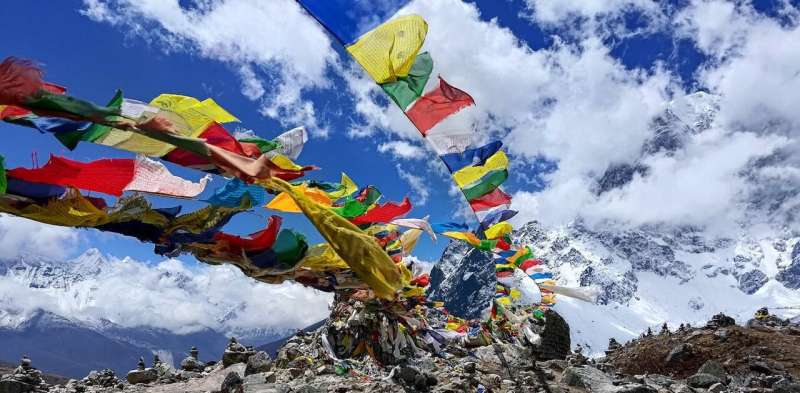
Mountains—their height, their mass, their climates and ecosystems—have fascinated humans for thousands of years. But there is one that holds extra-special meaning for many—Mount Everest, or Chomolungma as the Nepalese Sherpa people call it.
A sacred mountain for some, for others the world's highest peak represents a challenge and a lifelong dream. Seventy years ago, on May 29, 1953, that challenge and dream became reality for two members of a British expedition : New Zealander Edmund Hillary and Sherpa Tenzing Norgay became the first people to reach the 8,848.86-meter summit.
Their achievement was a testament to endurance and determination. It was also the crowning glory of the British expedition's nationalistic motivations on the eve of the young Queen Elizabeth's coronation.
From our vantage in the present, it also represents a high point, not just in climbing terms, but in what we now think of as the modern era of mountaineering. Since then, mountaineering has become massively popular and commercial—with serious implications for the cultures and environments that sustain it.
Scaling the heights
The early mountaineering era began in 1786 when Jaques Balmat and Michel Paccard reached the summit of Mont Blanc, the highest peak in the European Alps at 4,808 meters. From 1854 to 1899 (known as the classic mountaineering period), advances in climbing technology saw ascending peaks by challenging routes become possible and popular.
During the modern era from 1900 to 1963, mountaineers pushed further into the Andes cordillera in South America, explored polar mountains and began high-altitude climbing in Central Asia.
Shishapangma, the last of the world's 8,000-meter peaks to be climbed, was scaled in 1964 , marking the start of contemporary mountaineering. Since then, all of the world's 8,000-meter peaks have been climbed in winter, culminating in the historic winter scaling of the 8,611-meter K2 by a Nepalese expedition in 2021.
The record-setting assault on the world's 14 highest peaks by Nirmal Puja in 2019 set the stage for a new period of commercial mass mountaineering—involving expectations and conditions that would have stunned the likes of Hillary and Norgay.
Mass mountaineering
The relatively recent influx of what some call novice mountaineers , who may expect luxury packages and a guarantee of summiting, can have dangerous consequences.
Sleeping in heated tents, not preparing their own food or helping to move equipment, does not test mental and physical fitness in such challenging environments. Pushing to the summit may put their own lives, and the lives of other climbers and rescue teams, at risk.
And yet the number of people attempting to climb famous peaks such as Kilimanjaro in Tanzania or Aconcagua in Argentina has increased dramatically. In 2019, there were 878 successful summits on Everest alone.
The days when true mountaineers were looking for new routes and climbing with minimum support have almost disappeared from commercial peaks like Everest. And many of these commercial climbers would not have a chance without professional support.
In 1992, for example, when the first commercial mountaineering expeditions on Everest began, 22 Sherpas and 65 paying mountaineers summited—one Sherpa for three clients. Nowadays , two or even three Sherpas for each member of a commercial expedition is common.
But the romance and achievements of past mountaineers, combined with social media images and an "all-inclusive" adventure tourism industry, can lull inexperienced climbers into a false sense of security. On Everest, this has led to overcrowding, environmental degradation and increased risks for all climbers .
During the first two years of the COVID-19 pandemic, Nepal's Khumbu region—where Everest sits—was effectively shut for climbing. This year, however, some estimate a record of more than 1,000 people could reach the summit.
The next challenge
Experienced mountaineers are responding to the challenges of overcrowding, pollution and socio-cultural impacts on mountain communities by advocating for more responsible and sustainable mountaineering practices.
They want stricter regulations and better training to protect the fragile ecosystems of the Himalayas and other mountain ranges worldwide.
This will require many stakeholders to play their part, including governments, mountaineering organizations, tourism operators and local communities. Ultimately, the future of mountaineering depends on preserving these unique mountain environments in the first place.
Finally, maybe it's time to introduce minimum skill requirements for climbing the world's highest peak.
As we mark the 70th anniversary of the first ascent of Everest, we need to reflect on the changes that have taken place in mountaineering since. Paradoxically, while it has become more accessible and popular, it has also become more challenging and complex.
Meeting those challenges and solving the problems will be the best way to honor the extraordinary achievement of Edmund Hillary and Tenzing Norgay.
Provided by The Conversation
Explore further
Feedback to editors

Researchers reveal how molecular roadblocks slow the breakdown of cellulose for biofuels

In South Africa, tiny primates could struggle to adapt to climate change
2 hours ago


Study reveals flaw in long-accepted approximation used in water simulations

Researchers develop nanotechnology for creating wafer-scale nanoparticle monolayers in seconds
3 hours ago

Study underscores new strategies to fight drug-resistant bacteria

Researchers establish commercially viable process for manufacturing with promising new class of metals
4 hours ago

Chimps shown to learn and improve tool-using skills even as adults
5 hours ago

Advanced experimental setup expands the hunt for hidden dark matter particles
6 hours ago

New research confirms that Beethoven had lead poisoning—but it didn't kill him

How NASA's Roman mission will hunt for primordial black holes
Relevant physicsforums posts, the secrets of prof. verschure's rosetta stones.
May 2, 2024
Large eruption at Ruang volcano, Indonesia
Tidal friction and global warming.
Apr 20, 2024
Iceland warming up again - quakes swarming
Apr 18, 2024
M 4.8 - Whitehouse Station, New Jersey, US
Apr 6, 2024
Major Earthquakes - 7.4 (7.2) Mag and 6.4 Mag near Hualien, Taiwan
Apr 5, 2024
More from Earth Sciences
Related Stories

Another day at the office: Sherpa completes record 23rd Everest climb
May 15, 2019

Why is climbing Mount Everest so dangerous?
May 25, 2023

Sherpa guide scales Mount Everest for record 25th time
May 7, 2021

Nepal to send team to clean Mount Everest
Apr 11, 2019

Norwegian climber 1st to test positive on Mount Everest
Apr 23, 2021

'Traffic jam' on Everest as two more climbers die reaching summit
May 23, 2019
Recommended for you

Computer models show heat waves in north Pacific may be due to China reducing aerosols
9 hours ago

Study identifies early warning signals for the end of the African humid period
8 hours ago

Discharge of scrubber water into the Baltic Sea is responsible for hundreds of millions in costs
14 hours ago

Researchers find Northern Hemisphere glaciation enhances orbital- and millennial-scale Asian winter monsoon variability
May 6, 2024

Turbid waters keep the coast healthy, finds study

Research quantifies 'gap' in carbon removal for first time—shows countries need more awareness, ambition and action
May 3, 2024
Let us know if there is a problem with our content
Use this form if you have come across a typo, inaccuracy or would like to send an edit request for the content on this page. For general inquiries, please use our contact form . For general feedback, use the public comments section below (please adhere to guidelines ).
Please select the most appropriate category to facilitate processing of your request
Thank you for taking time to provide your feedback to the editors.
Your feedback is important to us. However, we do not guarantee individual replies due to the high volume of messages.
E-mail the story
Your email address is used only to let the recipient know who sent the email. Neither your address nor the recipient's address will be used for any other purpose. The information you enter will appear in your e-mail message and is not retained by Phys.org in any form.
Newsletter sign up
Get weekly and/or daily updates delivered to your inbox. You can unsubscribe at any time and we'll never share your details to third parties.
More information Privacy policy
Donate and enjoy an ad-free experience
We keep our content available to everyone. Consider supporting Science X's mission by getting a premium account.
E-mail newsletter
The NeverRest Project
The neverrest project and the government of nepal join forces to tackle the major environmental challenges at mount everest.

A multidisciplinary team of top-level specialists is working on technological solutions to eliminate the waste buildup from over 40 years of commercial expeditions and design a sustainable Base Camp.
- The NeverRest Project and the Government of Nepal aim to make Mount Everest an international benchmark for sustainability and environmental management.
- Assessing visitor environmental impact is a top priority for sustainability awareness.
- Participating specialist collaborators include Kilian Jornet, Alex Txikon, Tamara Lunger, Simone Moro, and Lakpa Nuru Sherpa, along with Himalayan Database managing director Billi Bierling.
- HyperloopTT, a transportation and technology licensing company, brings its experience and expertise in crowd-sourcing management to connect with talent from around the world.
The NeverRest Project and the Nepal Tourism Board of the Government of Nepal are working together on the most significant environmental endeavor ever undertaken at Mount Everest. The goal is to turn the world’s highest mountain into an international benchmark for sustainability and environmental management, while working in close collaboration with local Nepalese communities.
About The NeverRest Project
The NeverRest Project is an environmental engineering and technology corporation committed to instituting a providing action systems and a self-sufficient circular economies to achieve optimal environmental protection and management to strike a better balance between tourism and the ecosystem .
The NeverRest Project team consists of engineers, technology specialists, biologists, climate change experts and mountaineers , among others, who are already working on a number of transdisciplinary solutions and prototypes to clean up the highest mountain in the world after over forty years of commercial expeditions resulting in an enourmous amount of waste buildup in the area .
The NeverRest Project team is also working on planning and designing a sustainable base camp at which the waste management problem is solved while also benefiting the people in the area, both local communities and the various players in the high-altitude and mountain tourism industry.
“All the world is talking about sustainable mountain and tourism. Nepal is also facing the same problem and this question always is in front of us when we are promoting the mountains for tourism activities. So, this is the time we start to think jointly to find permanent solutions. I’m talking about the problem of the garbage, especially the garbage management in the remote areas, where we don’t have transportation facilities and where we are the mountain and trekking activities mostly take place. So when people are going up they are not thinking about what there are carrying with them, and they enjoy, but what they are leaving behind them, this is the big question. Every government cannot be cleaning all the time, so we need to find a sustainable way. This is the main question we need to addressed, so it cannot be address only by one office or one country, it should be something jointly we have worked together, all the mountaineering community and the people who are depending on mountain tourism. We must work together. with mountaineering communities. So let’s work together”, said CEO of the Nepal Tourism Board, Dr. Dhananjay Regmi , who expressed his support for The NeverRest Project: “ It is really good and I want to support this project because Nepal really needs it”.
Frédéric Kauffmann , CEO and founder of The NeverRest Project , stated tha t “ for years, we have known about several cases of imbalances caused by the human impact on natural ecosystems due to mass tourism; so, four years ago, we launched a project to bring together the best talent, innovation, and creativity to leap into action and reverse this situation .”
The phases of The NeverRest Project
There are five principal phases:
- Measuring the environmental impact on Mount Everest. A field survey will be carreid out to analyze the current status of the mountain and determine the volume of waste builtup.
- Designing a Sustainable Base Camp. The NeverRest Project’s team of engineers and local experts will design a sustainable sanitation system for the Nepalese Government at Everest Base Camp to manage its waste.
- Environmental impact assessment. We plan to involve mountaineers and trekkers in assessing their environmental impact to raise awareness of the importance of respecting the environment while generating greater benefit to both the ecosystem and local communities.
- Fortifying the role of local specialists. In collaboration with the Government of Nepal, we will strengthen the profile of local mountain specialists in environmental and waste management education, outreach, and training programs for national and international visitors, universities, and schools.
- Cleaning up Mount Everest. A transdisciplinary team of local and international specialists will carry out a comprehensive cleanup project at Mount Everest in Nepalese territory.
T he real issue
In recent years, more work has been done to solve and promote greater awareness of global problems such as climate change, mass tourism, the human impact on ecosystems, pollution, and waste and resource management . This has made it possible to reach international agreements such as the 2030 Agenda and the European Green Pact .
Globalisation, economic and social crises, and the fact that we live in changing and uncertain times all lead to the proliferation of short-term benefits that not only do not solve our problems, but also have a negative impact on our economic and social systems. This has been the case with countless environmental catastrophes, including the unsatisfactory management of natural spaces. While we are not all guilty at an individual level, neither are we entirely innocent.
At The NeverRest Project, we know that the solution is not to simply cancel all tourism; it involves making it more of a conscious ordeal, and balancing tourism with the benefit of local populations and their economy. We believe that the immediate future will involve regenerative tourism based on sustainability, zero environmental and energetic impact from the visitor, and not degrading the local scenery and coexistence, but rather promoting it. Ultimately, out-of-control tourism not only leads to the destruction of the destination and its environment, but it also makes to replace it with another destination.
The problem on Mount Everest
Both the SPCC and the Nepal Mountaineering Association , two important voices in Nepal, and the IUNC , the world’s largest environmental organisation, agree that the notable increase in visitation to the Mount Everest area in recent years has brought along significant waste management complications .
Everest is a highly fragile icon of our planet, and in 2014, it was riddled with roughly 50 tonnes of rubbish , according to estimates made public that year by the Nepalese Government.
The Sagarmatha Pollution Control Committee (SPCC) , the NGO designated by the government to take charge of waste monitoring and environmental management at the Sagarmatha National Park (the Everest region), claimed in its annual report that it had removed some 7.5 tonnes of garbage from expeditions in the Khumbu area between 2019 and 2020. There were 60 tonnes in 2017-2018, plus 165 tonnes of waste from Namche, Lukla, and the surrounding areas. From 2018-2019, there were 251 tonnes of it. But each year, new expeditions and trekking groups arrive in the Everest area causing the situation to perpetuate, despite seasonal waste removal and recycling campaigns with locally-based companies. “The enormous increase of visitors to the Everest region during the last quarter century has tremendously supported the local economy. Nevertheless, the pressure exerted from tourism has also resulted in increased environmental degradation from waste. With an increase in the number of visitors, littering of trash along trekking trails has become prominent”, the SPCC’s latest report notes.
The kinds of garbage that are most frequently found in the mountains are as follows, classified by the SPCC:
- Disposable (burnable and biodegradable): paper, cardboard, packaging, clothes, food scraps, etc.
- Non-disposable: cans, bottles, EPI gas canisters, oxygen tanks, batteries, etc.
The IUNC World Heritage , as the international body that analyses the status of World Heritage sites, argued in its 2020 report that, in 2018, there were 35,000 kilos of waste on the mountain , and it was considered “critical” to highlight that, between 2014 and 2016, there was an average annual visitor level of 30,000 people to the region, while there were 57,000 between 2018 and 2019. This means there was an almost 100% increase in just three years , which “puts enormous pressure on all aspects of visitor management, particularly waste management in remote areas” .
In the summer of 2022, the Nepalese Army, in collaboration with government institutions, carried out a Mountain Clean-up campaign and remove a total of 33,877 kilos of garbage from the slopes of Everest, Lhotse, Manaslu, and Kangchenjunga , where they also recovered two bodies.
The actual amount of waste and rubbish on Mount Everest remains uncertain due to a lack of information , and varies depending on the source. Therefore, The NeverRest Project ‘s priority will be to survey the area to determine the actual situation.
T he NeverRest Project’s scientific team
The NeverRest Project has an expert committee made up of scientists specialized in environment and climate change, biology, ice and glacier research, with the collaboration of the biologist María Urieta , in collaboration with local Nepali specialists in waste management in Mount Everest and the surrounding areas in Khumbu and Sagarmatha National Park.
Alton C. Byers , Ph.D. is a mountain geographer, conservationist, and mountaineer specializing in applied research, high altitude ecosystems, climate change, glacier hazards, and integrated conservation and development programs.
The NeverRest Project’s team of mountain and tourism specialists
The NeverRest Project has a team of top-level specialists in the Himalayas and mountains in general who will provide site-specific expertise in collaboration with the Nepalese Government, local tourism, and community associations.
Some of the contributors are top athlete Kilian Jornet , Basque mountaineer Alex Txikon , who has reached the summit of all 14 eight-thousanders, Italian climber Tamara Lunger , the youngest climber to have reached the main summit of Lhotse, and Simone Moro , an Italian mountaineer who became famous beyond the Himalayas for a rescue at over 8,000 metres that earned him numerous awards and the Gold Medal for Civil Courage.
In the realm of documentation, we have the German journalist, mountaineer, and managing director of the Himalayan Database, Billi Bierling , and the mountain and climbing guide, Fernando Peralta .
Nepalese mountain guide and writer, Lakpa Nuru Sherpa , who has reached the summit of Mount Everest three times, also contributes local knowledge and a Nepalese point of view on sport mountaineering and the mountain and altitude tourism industry in Nepal to the field.
The NeverRest Project and HyperloopTT
The NeverRest Project is supported by HyperloopTT, a transportation and technology licensing company, with which it signed a partnership agreement in 2021.
Andrés de León , CEO of HyperloopTT , stated: “ HyperloopTT decided to support The NeverRest Project because we truly believe it is a necessity. If we look at our own history, sustainability is clearly in our genes. Our approach to developing HyperloopTT is based on efficient energy, developing truly sustainable materials. Therefore, supporting initiatives like The NeverRest Project , which are truly going to change the world at a crucial time for humanity, was an obligation for us. So, we are going to help The NeverRest Project with all our experience, knowledge, and capabilities, because we truly believe in this project”.
The NeverRest Project team is working with the innovative Lucy technology , used by HyperloopTT . This is an online work management platform , supported by artificial intelligence and international in its scope, which helps coordinate teams, put s specialists in contact with one another to solve problems and compile s the progress of each expert in the project.
M eeting SDGs
The NeverRest Project ‘s actions meet nine of the 17 Sustainable Development Goals ( SDGs ) of the 2030 Agenda :

3. Good health and well-being
4. Quality education
6. Clean water and sanitation
8. Decent work and economic growth
9. Industry, innovation and infrastructure
11. Sustainable cities and communities
13. Climate action
15. Life on land
17. Partnerships for the goals
For more information and interviews:
theneverrestproject
Discover more from The NeverRest Project
Subscribe now to keep reading and get access to the full archive.
Type your email…
Continue reading

China’s New Road May Clear a Path for More Everest Climbers
The road to Everest is paved—and, at least in terms of this feat of engineering, it is magnificent. China has completed a pristine asphalt highway across the Tibetan plateau, with views of 8,000-meter mountains, all the way to Everest Base Camp North. “If this road were anywhere else on the planet, it would be the…
The road to Everest is paved—and, at least in terms of this feat of engineering, it is magnificent.
China has completed a pristine asphalt highway across the Tibetan plateau, with views of 8,000-meter mountains, all the way to Everest Base Camp North.
“If this road were anywhere else on the planet, it would be the most unbelievable road-biking stage of a race you could possibly imagine,” said Adrian Ballinger, a mountain guide from California, who is currently attempting to climb Everest without oxygen from the north side with his partner Cory Richards, a National Geographic photographer from Colorado. “Millions of switchbacks, going over 17,000-foot passes. Unbelievable views of everything from Shisha Pangma to Cho Oyu, Everest, Makalu, and Lhotse. As a tourist attraction, it’s one of the coolest roads I’ve seen anywhere on the planet.”
The road literally goes right to base camp. Tourist buses must stop about a mile back from the 14,000-foot camp, but climbers are permitted to drive right to their tent spots. This is a stark contrast to the South Side Base Camp in Nepal, which demands a ten-day trek up the Khumbu Valley.

The completed road is just one of the many recent China-led developments that is widening the disparity of experience between climbing Everest from the north versus the south. What’s interesting is how China appears to be paving the way, literally and figuratively, to creating a more progressive Everest.
“There are a lot of issues with China,” says Ballinger, “and getting into the country is one of them. But over the last five years, they have become more forward thinking in their management of Everest. They now have strong government ranger presence on the mountain, not only at base camp. They regulate trash. They fix the ropes all the way to the summit. And they’ve done things like remove all the dead bodies from the north side of the mountain. They’re very proud that Everest is part of China, through Tibet. I really see a change here.”
Ballinger, 40, is a veteran high-altitude IFMGA-certified mountain guide who has reached Everest’s summit seven times, though never without oxygen. He began cutting his teeth on Everest by first working for the renowned guiding outfit Himalayan Experience (HIMEX), but now he runs his own company, Alpenglow Expeditions, in Squaw Valley, California.
“If you look at the Seven Summits,” Ballinger says, referring to the highest mountains on each of the seven continents, “every single one has gone through this process of becoming popular and becoming a complete trash-heap disaster. Denali, for example, was a disaster of human waste until the U.S. government stepped up with their climber ranger program and started managing the climbers. Kilimanjaro and Aconcagua have also gone from dirty and chaotic mountains to pristine, incredible places. The same needs to happen on Everest, and it will only happen through government regulation. Because as long as low-budget companies are able to come in and make money, it will continue to go down hill. China seems to be taking that on. Nepal has not yet taken that on.”
A Tale of Two Everests
The summit of Mount Everest sits exactly on the border between Nepal and Tibet; officially, the Tibet Autonomous Region of the People’s Republic of China. One of the first decisions to be made, upon committing even to try to climb the tallest mountain in the world, is from which side you shall launch your ascent.
The variables that might factor into that decision are constantly evolving, now more than ever. Travel time, the political climate of China, the cultural experience you might be seeking, a preference for one commercial guide outfit over the other, ethical questions about Sherpa labor, and, of course, the climbing route itself—its difficulty, crowdedness, and statistical success rate and mortality rate—all might affect whether one chooses to climb Everest from the south, Nepal side, or from the north, Tibet side.
Ballinger and Richards are currently looking to add their names to the relatively short list of folks who have summited Everest without using supplemental oxygen. Since Reinhold Messier and Peter Habbler became the first people to climb Everest without oxygen in 1978, nearly 200 other people have also achieved this impressive goal; compare that to the more than 4,000 individuals who have reached Everest’s summit using oxygen.
Due to the fact that some individuals, mostly hired Sherpas, have reached the summit multiple times, Everest has been climbed just over 7,000 times, with only 282 deaths, a relatively low (4 percent) mortality rate for Himalayan mountaineering. How that breaks down is over 4,400 summits and 176 deaths on the South Side, and over 2,580 summits and 106 deaths on the North Side.
In the early 2000s, most guides staged their operations through Tibet. However, acquiring climbing permits from China soon proved itself to be unreliable, and most operations abandoned the north for the south.
By going through Nepal, guide companies enjoyed more reliable access to the mountain and lax regulation. In return, Nepal, one of the poorest countries in the world, began collecting well over $3 million annually from the growing business of Everest tourism. As a side note, Nepalese Sherpa workers on Everest, who might earn at most $5,000 per season, have become some of the country’s wealthiest residents.

One major obstacle to climbing Everest from the South Side is the notorious Khumbu Ice Fall, where most deaths on Everest have occurred over the past 15 years, with a majority of those deaths being Sherpas. In 2014, a falling serac crushed 14 Sherpa/Nepali workers in the Ice Fall. The disaster raised ethical questions about how Sherpas are taking disproportionate risks while fixing ropes through the Ice Fall, fixing ropes to the summit, and carrying hundreds of loads up the mountain, compared to the actual “climbers,” those who pay upwards of $65,000 to reach to the top of the world and spend relatively limited time exposed to the objective hazards of the mountain.
After the 2014 disaster, a few guide companies, such as Ballinger’s Alpenglow Expeditions, switched operations back to Tibet, if for no other reason than to avoid the treacherous Khumbu Ice Fall.
The difference in safety of the two routes became very apparent in 2015, when a 7.8 magnitude earthquake struck Nepal. There were quite a few climbers on Everest when the earthquake struck; a couple hundred on the south side at Camp 2, around 6,500 meters.
Meanwhile, on the north, Tibet side of the mountain, there was a small team of working Sherpa climbers who were fixing ropes at well above 8,000 meters, just shy of the summit.
As the tremendous massif shook and trembled, incredibly, no climbers who were actually on the mountain were injured. It was a different story in Everest Base Camp, however. The earthquake sent a massive avalanche tearing through the Khumbu Ice Fall, which destroyed the network of ladders and ropes needed to navigate this section, and ultimately blasted through Base Camp, killing 18 people.
When the tremors stopped, the 160 to 180 climbers who were stationed at around 6,400 meters at Camp 2 on Everest’s South Side needed to call in a helicopter rescue as they were unable to descend through the avalanche-ravaged Khumbu Ice Fall.

The climbers on the North, above 8,000 meters, however, simply walked down the mountain.
On The North Side
There seem to be only a few downsides to climbing Everest from the North. Acquiring permits through China can be hit or miss. The climbing skills of Tibetan Sherpas are, in general, not as well developed as their Nepali counterparts. And while you can now drive right to Everest North Base Camp, the camp itself is much windier and a big higher than the South Side.
We caught up with Ballinger and Richards to hear more about how things have changed on Everest North.
You left the U.S. 18 days ago, and just reached Everest Base Camp. What was it like?
AB: It’s been quite a journey. Compared to trekking through the Khumbu, it’s so much faster to come here. It’s possible to reach the North camp in three to six days, compared to 10 to 12 on the South side. But this is an entirely different experience. Now, you drive on this beautiful blacktop road. We were in a brand-new bus, and staying in nice hotels with good WiFi and clean sheets and hot water. IT’s changed so much since 2007. Back then, I remember rats in my hotel bathroom, cockroaches under my bed, and just unimaginably dirty bathrooms. Now, eight years later, I could take my parents across the Tibetan plateau.
- Nat Geo Expeditions
Has China had a heavy hand in this development?
AB: Yeah, for sure China is responsible, but hopefully it has been in some sort of partnership with the Tibet Autonomous Region. Certainly, we’ve seen a lot of Tibetan businesses along the way, we’ve eaten in Tibetan-owned restaurants, and all the hotels we’ve stayed i have been primarily Tibetan owned, although we’ve seen a number of Han Chinese officials around as well.
What else is different?
AB: Certainly, all these new creature comforts of coming across the Tibetan Plateau and up to base camp. It used to be a dirt road and take five brutal days. But now, even base camp is different. There’s a strong liaison-officer presence here as well, and I find that really refreshing after being on the Nepal side. The liaison officers are a mix of Tibetan and Chinese, and they’ve been coming by our camp every day, giving us updates on things like rope-fixing on the mountain, and helping us organize our yaks for reaching advanced base camp. Overall they seem very professional.
CR: There’s an interesting sidebar here as well, because people can criticize, “Well, how much of an adventure can it be when you’re driving to base camp?” But the fact that you can drive here has allowed the Chinese government to manage this base camp much better, simply by virtue of the road. Also, this camp feels empty and even cleaner compared to the South Side, and I think that’s based on how it’s structured. People don’t really clean up after themselves the South Side, but it feels much more kept here.
What are the drawbacks to being on the North Side?
AB: Wind is intense here. Every day, we are dealing with 30- to 50-mile-per-hour winds.
CR: There’s also something to be said for the South Side experience, where you walk into Base Camp up the Khumbu Valley. You’re adding money into the region and supporting all these businesses, and having this great cultural experience. There’s something special about that.
AB: I guess I can offer a counterpoint to that, which is, if you want to have a cultural experience, do that after you climb the mountain, or do it separately. I’ve seen so many climbers get really sick during the trek into the South Side base camp, and it can ruin people’s climbs. Another thing is that there’s no helicopter rescues here on the North Side. The Chinese don’t permit helicopters on the mountain, so that’s a big amount of responsibility for guides and medics.
CR: On the other hand, that fact increases the self-sufficiency you need to have to climb Everest, which is a good thing. If shit goes wrong, you have to deal.
Related Topics
- MOUNTAIN CLIMBING
You May Also Like

Where to stay in Denver, gateway to the Rockies

Why visit Annecy, gateway to the shores and summits of the French Alps

Sleeper trains, silent nights and wee drams on a wild walk in Scotland

What you need to know about volcano tourism in Iceland

Get ready for your next iconic adventure like a pro with these tips

Why Scotland should be your next ski destination

What it's like to visit the Swiss mountains in winter
- Environment
History & Culture
- History & Culture
- History Magazine
- Mind, Body, Wonder
- Coronavirus Coverage
- Paid Content
- Terms of Use
- Privacy Policy
- Your US State Privacy Rights
- Children's Online Privacy Policy
- Interest-Based Ads
- About Nielsen Measurement
- Do Not Sell or Share My Personal Information
- Nat Geo Home
- Attend a Live Event
- Book a Trip
- Inspire Your Kids
- Shop Nat Geo
- Visit the D.C. Museum
- Learn About Our Impact
- Support Our Mission
- Advertise With Us
- Customer Service
- Renew Subscription
- Manage Your Subscription
- Work at Nat Geo
- Sign Up for Our Newsletters
- Contribute to Protect the Planet
Copyright © 1996-2015 National Geographic Society Copyright © 2015-2024 National Geographic Partners, LLC. All rights reserved
Accommodation
Government & Politics
Infrastructure
Environment
Research & Reports
Asia Pacific
North America
South America
Middle East & Africa
Perspectives: 70 years ago today, Mt Everest was conquered – now, mass mountaineering must be addressed
29th May 2023 By Contributor
Seventy years ago today, Kiwi Edmund Hillary and Sherpa Tenzing Norgay reached the summit of Mt Everest. Now, mountaineering is hugely popular and commercial but that has come at a cost, write tourism researchers.

Mountains – their height, their mass, their climates and ecosystems – have fascinated humans for thousands of years. But there is one that holds extra-special meaning for many – Mount Everest, or Chomolungma as the Nepalese Sherpa people call it.
A sacred mountain for some, for others the world’s highest peak represents a challenge and a lifelong dream. Seventy years ago, on May 29, 1953, that challenge and dream became reality for two members of a British expedition : New Zealander Edmund Hillary and Sherpa Tenzing Norgay became the first people to reach the 8,848.86-metre summit.
Their achievement was a testament to endurance and determination. It was also the crowning glory of the British expedition’s nationalistic motivations on the eve of the young Queen Elizabeth’s coronation.
From our vantage in the present, it also represents a high point, not just in climbing terms, but in what we now think of as the modern era of mountaineering. Since then, mountaineering has become massively popular and commercial – with serious implications for the cultures and environments that sustain it.

Scaling the heights
The early mountaineering era began in 1786 when Jaques Balmat and Michel Paccard reached the summit of Mont Blanc, the highest peak in the European Alps at 4,808 metres. From 1854 to 1899 (known as the classic mountaineering period), advances in climbing technology saw ascending peaks by challenging routes become possible and popular.
During the modern era from 1900 to 1963, mountaineers pushed further into the Andes cordillera in South America, explored polar mountains and began high-altitude climbing in Central Asia.
Shishapangma, the last of the world’s 8,000-metre peaks to be climbed, was scaled in 1964 , marking the start of contemporary mountaineering. Since then, all of the world’s 8,000-metre peaks have been climbed in winter, culminating in the historic winter scaling of the 8,611-metre K2 by a Nepalese expedition in 2021.
The record-setting assault on the world’s 14 highest peaks by Nirmal Puja in 2019 set the stage for a new period of commercial mass mountaineering – involving expectations and conditions that would have stunned the likes of Hillary and Norgay.
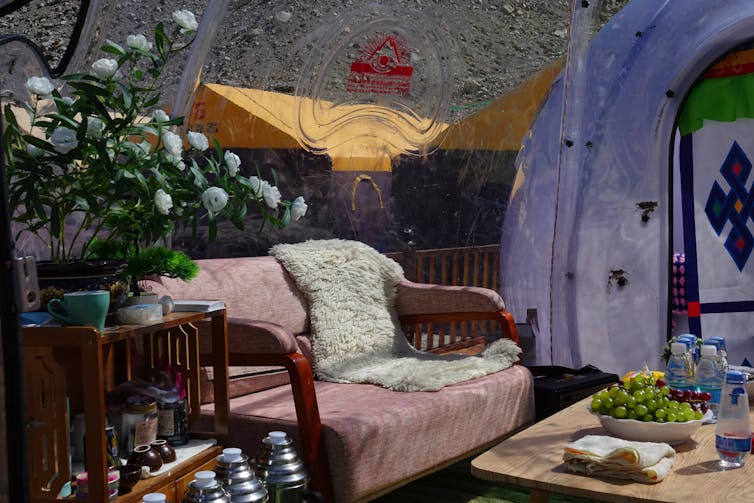
Mass mountaineering
The relatively recent influx of what some call novice mountaineers , who may expect luxury packages and a guarantee of summiting, can have dangerous consequences.
Sleeping in heated tents, not preparing their own food or helping to move equipment, does not test mental and physical fitness in such challenging environments. Pushing to the summit may put their own lives, and the lives of other climbers and rescue teams, at risk.
And yet the number of people attempting to climb famous peaks such as Kilimanjaro in Tanzania or Aconcagua in Argentina has increased dramatically. In 2019, there were 878 successful summits on Everest alone.
The days when true mountaineers were looking for new routes and climbing with minimum support have almost disappeared from commercial peaks like Everest. And many of these commercial climbers would not have a chance without professional support.
In 1992, for example, when the first commercial mountaineering expeditions on Everest began, 22 Sherpas and 65 paying mountaineers summited – one Sherpa for three clients. Nowadays , two or even three Sherpas for each member of a commercial expedition is common.
But the romance and achievements of past mountaineers, combined with social media images and an “all-inclusive” adventure tourism industry, can lull inexperienced climbers into a false sense of security. On Everest, this has led to overcrowding, environmental degradation and increased risks for all climbers .
During the first two years of the Covid-19 pandemic, Nepal’s Khumbu region – where Everest sits – was effectively shut for climbing. This year, however, some estimate a record of more than 1,000 people could reach the summit.
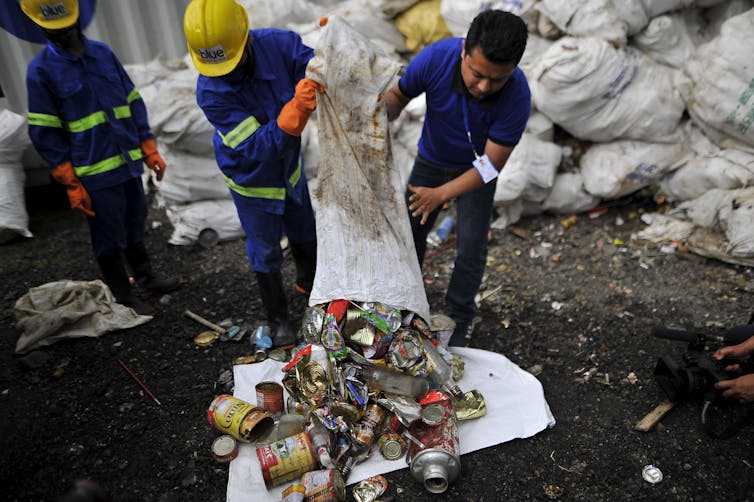
The next challenge
Experienced mountaineers are responding to the challenges of overcrowding, pollution and socio-cultural impacts on mountain communities by advocating for more responsible and sustainable mountaineering practices.
They want stricter regulations and better training to protect the fragile ecosystems of the Himalayas and other mountain ranges worldwide.
This will require many stakeholders to play their part, including governments, mountaineering organisations, tourism operators and local communities. Ultimately, the future of mountaineering depends on preserving these unique mountain environments in the first place.
Finally, maybe it’s time to introduce minimum skill requirements for climbing the world’s highest peak.
As we mark the 70th anniversary of the first ascent of Everest, we need to reflect on the changes that have taken place in mountaineering since. Paradoxically, while it has become more accessible and popular, it has also become more challenging and complex.
Meeting those challenges and solving the problems will be the best way to honour the extraordinary achievement of Edmund Hillary and Tenzing Norgay.
Yana Wengel is Associate Professor in Tourism and Geography at Hainan University ; Dr Adele Doran is Senior Lecturer in Tourism Management at Sheffield Hallam University , and Michal Apollo is Adjunct Professor of Earth Science, University of Silesia in Katowice .
This article is republished from The Conversation under a Creative Commons license. Read the original article .
Related Articles
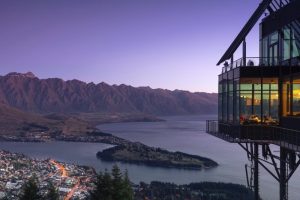
9 Apr 2024 Queenstown hosts sister city delegation
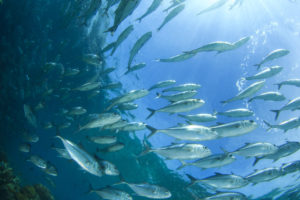
2 Apr 2024 Govt scraps Kermadecs marine sanctuary bill

28 Feb 2024 Perspectives: Do major sporting events really benefit destinations? It depends

19 Feb 2024 An Operator’s View: Tasman Holiday Parks’ David Aflallo

15 Feb 2024 Perspectives: The value of mega events for tourism
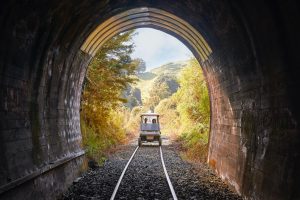
12 Feb 2024 An Operator’s View: Forgotten World Adventures’ Grant Ross

8 Feb 2024 Perspectives: Can e-bikes be a solution to sustainable transport in rural tourist areas?

5 Feb 2024 An Operator’s View: Reaping the benefits of Splash Planet’s $2.4m makeover

8 May 2024 RAL / Ski Fields
Whakapapa puts best foot forward for season, hopes for sale, 8 may 2024 cruise / nzca, nz cruise sets out to bust myths with new resource for tourism…, 8 may 2024 cruise / perspectives, …as the cruise industry booms post-covid, but with challenges to meet, 8 may 2024 roundup, wednesday 8 may, 7 may 2024 destination wairarapa / rto, an open letter to councillors: a lot of families rely on wairarapa tourism, 7 may 2024 thl, thl “positive” on long-term prospects but shares fall 36% after downgrade.
Home Roundup People Events Campaigns Transport Activities
Accommodation Government & Politics Infrastructure Māori Environment Technology
Data Research & Reports Features Resources Companies Jobs Market Calendar
China Australia Asia Pacific North America South America Europe Middle East & Africa
About Contact Newsletters
Advertise Sponsor Subscribe
NZ Media Council Privacy Policy Terms & Conditions
© 2024 Business Media Network Ltd Website by Webstudio

IMAGES
VIDEO
COMMENTS
The tolls, however, can be vast. Though tourism to Everest brings in $300 million to Nepal every year, there is a human toll. More than 300 people have died on the mountain since 1953. This year's climbing season saw 11 deaths, marking the deadliest season since 2015 when an avalanche killed 19 people at a base camp following a 7.8 earthquake.
In Japan there is growing concern with "kankō kōgai", or "tourism pollution", crowding locals out of sites of national value. In 2016, Machu Picchu in Peru took 5,000 visitors a day ...
The journey was everything; the outcome never a forgone conclusion. Now, Everest has become the ultimate tick on the global adventure-tourism circuit. But, as the famous Tyrolean climber Reinhold ...
It should include trained western and local guides and can be supported by the profits from local tourism. The Nepalese government earns US$3.3 million annually in Everest-related climbing royalty ...
Published: June 7, 2019 8:53am EDT. The last days of Mt Everest's spring window for 2019 witnessed the deaths of 11 climbers. Images of hundreds of mountaineers queuing to reach the summit and ...
Since Edmund Hillary and Tenzing Norgay conquered Everest/Chomolungma in 1953, commercial mass ... Death on Everest: the boom in climbing tourism is ... waste collected from Mount Everest base ...
Microplastic pollution at the highest point on Earth is a direct result of increased tourism and waste accumulation. A large proportion of that waste is made out of non-biodegradable plastic. ... King et al.: "Six decades of glacier mass changes around Mt. Everest revealed by historical and contemporary images," an Article publishing in One ...
Rising to 29,032ft on the border between Nepal and Tibet, Mount Everest — known as Sagarmatha by the Sherpa people of Nepal — has held an almost mystical allure for climbers and hikers since ...
Overcrowding at Mount Everest: How the world's highest mountain became a tourist attraction By Jacob Bogage Updated June 3, 2019 — 4.26pm first published at 10.41am
File photo. A general view of the Everest base camp taken from a drone, in Nepal, Apr 24, 2023. (Photo: Reuters/Pasang Rinzee Sherpa) Tents at Camp 2 at around 6,400m on Mount Everest in Nepal ...
70 years after the first ascent of Everest, the impact of mass mountaineering must be confronted, say researchers May 26 2023, by Yana Wengel, Dr. Adele Doran and Michal Apollo
The mission to clean up Mount Everest. Environmentalists in Nepal are pressing the government to keep the Himalayas free from litter. Suzanne Goldenberg. Mon 24 Oct 2011 15.00 EDT. T he people who ...
Climber and trekker numbers have skyrocketed in the past 20 years, exacerbating Mount Everest's trash problem, say these academics. This picture taken on May 23, 2010 shows a Nepalese sherpa ...
Mass tourism is a prominent part of the tourism industry. Associated with the traditional package holiday, well-known holiday resorts and famous tourist attractions, many areas both benefit and suffer at the hands of mass tourism. ... The most notable is on Mount Everest, where tourists have dies as a result of queuing at high altitude ...
Mass Tourism on Mount Everest. The Devastating Consequences College University of Applied Sciences Wernigerode Grade 2,0 Author Talisa Gassmann (Author) Year 2021 Pages 12 Catalog Number V1167336 ISBN (eBook) 9783346576736 ISBN (Book) 9783346576743 Language English Keywords mass, tourism, mount, everest, devastating, consequences ...
How Mount Everest became a tourist destination. By Jacob Bogage. May 31, 2019 at 6:00 a.m. EDT. Mountain climbers line a path on Mount Everest just below camp four, in Nepal. (Rizza Alee/AP)
In 2021, the Nepal Ministry of Tourism issued a record 408 Everest climbing permits, the highest in its history. Who are Everest's guides? For local logistics companies and the government of Nepal ...
A sacred mountain for some, for others the world's highest peak represents a challenge and a lifelong dream. Seventy years ago, on May 29, 1953, that challenge and dream became reality for two ...
The Impact Of Excessive Tourism In Mount Everest Harikumar Pallathadka Manipur International University, Imphal, Manipur, India [email protected] Abstract Mount Everest has the highest peak in the world. Since Tenz ing Norgay and Edmund Hillary first climbed the mountain over 60 years ago, over 3,000 people have proudly stood on its summit.
A multidisciplinary team of top-level specialists is working on technological solutions to eliminate the waste buildup from over 40 years of commercial expeditions and design a sustainable Base Camp. The NeverRest Project and the Government of Nepal aim to make Mount Everest an international benchmark for sustainability and environmental management.
The incredible new paved road from Lhasa to Everest Base Camp at 17,050. The road crosses multiple 5,000-meter-passes with incredible views of five 8,000-meter peaks; Photograph by Adrian ...
Perspectives: 70 years ago today, Mt Everest was conquered - now, mass mountaineering must be addressed. 29th May 2023 By Contributor. Seventy years ago today, Kiwi Edmund Hillary and Sherpa Tenzing Norgay reached the summit of Mt Everest. Now, mountaineering is hugely popular and commercial but that has come at a cost, write tourism researchers.
North Face of Everest as seen from the path to North Base Camp Everest and Lhotse from the south: in the foreground are Thamserku, Kangtega, and Ama Dablam. Mount Everest is Earth's highest mountain above sea level, located in the Mahalangur Himal sub-range of the Himalayas.The China-Nepal border runs across its summit point. Its elevation (snow height) of 8,848.86 m (29,031 ft 8 + 1 ⁄ 2 ...
Researchers surveyed nearly 80 glaciers around Mount Everest and found evidence of consistent glacial mass loss over the last 60 years and that glaciers are thinning, even at extreme altitudes above 6,000 meters.
Santorini To Machu Picchu To Mount Everest — The War Against Over-Tourism Is On. From setting new rules, imposing tolls and fines, local officials in some of the world's most desirable tourist spots are trying to figure out the right balance to keep visitors coming without ruining the environment, or the experience. Updated Feb. 16, 2024 at ...